Étiquette : Witelo
Van Eyck, a Flemish Painter using Arab Optics?
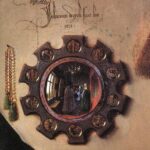

What follows is an edited transcript of a lecture by Karel Vereycken on the subject of “Perspective in XVth-century Flemish religious painting”.
It was delivered at the international colloquium “La recherche du divin à travers l’espace géométrique” (The quest for the divine through geometrical space) at the Paris Sorbonne University on April 26-28, 2006, under the direction of Luc Bergmans, Department of Dutch Studies (Paris IV Sorbonne University).
Introduction
« Perspective in XVth-century Flemish religious painting ». At first glance, this title may seem surprising. While the genius of fifteenth-century Flemish painters is universally attributed to their mastery of drying oil and their intricate sense of detail, their spatial geometry as such is usually identified as the very counter-example of the “right perspective”.
Disdained by Michelangelo and his faithful friend Vasari, the Flemish « primitives » would never have overcome the medieval, archaic and empirical model. For the classical “narritive”, still in force today, stipulates that only « Renaissance » perspective, obeying the canon of « linear », “mathematical” perspective, is the only « right », and the “scientific” one.
According to the same narrative, it was the research carried out around 1415-20 by the Duomo architect Filippo Brunelleschi (1377-1446), superficially mentioned by Antonio Tuccio di Manetti some 60 years later, which supposedly enabled Leon Battista Alberti (1404-1472), proclaiming himself Brunelleschi’s intellectual heir, to invent « perspective ».

In 1435, in De Pictura, a book entirely devoid of graphic illustration, Alberti is said to have formulated the premises of a perspectivist canon capable of representing, or at least conforming to, our modern notions of Cartesian space-time (NOTE 1), a space-time characterized as « entirely rational, i.e. infinite, continuous and homogeneous », « in one word, a purely mathematical space [dixit Panofsky] » (NOTE 2)
Long afterwards, in a drawing from the Codex Madrid, Leonardo da Vinci (1452-1519) attempted to unravel the workings of this model.
But in the same manuscript, he rigorously demonstrated the inherent limitations of the Albertian Renaissance perspectivist canon.

The drawing on f°15, v° clearly shows that the simple projection of visual pyramid cross-sections on a plane paradoxically causes their size to increase the further they are from the point of vision, whereas reality would require exactly the opposite. (NOTE 3)
With this in mind, Leonardo began to question the mobility of the eye and the curvilinear nature of the retina. Refusing to immobilize the viewer on an exclusive point of vision (NOTE 4), Leonardo used curvilinear constructions to correct these lateral deformations. (NOTE 5) In France, Jean Fouquet and others worked along the same lines.
But Leonardo’s powerful arguments were ignored, and he was unable to prevent this rewriting of history.
Despite this official version of art history, it should be noted that at the time, Flemish painters were elevated to pinnacles by Italy’s greatest patrons and art connoisseurs, specifically for their ability to represent space.
Bartolomeo Fazio, around the middle of the 15th century, observed that the paintings of Jan van Eyck, an artist billed as the « principal painter of our time », showed « tiny figures of men, mountains, groves, villages and castles rendered with such skill that one would think them fifty thousand paces apart. » (NOTE 6)
Such was their reputation that some of the great names in Italian painting had no qualms about reproducing Flemish works identically. I’m thinking, for example, of the copy of Hans Memlinc‘s Christ Crowned with Thorns at the Genoa Museum, copied by Domenico Ghirlandajo (Philadelphia Museum).
But post-Michelangelo classicism deemed the non-conformity of Flemish spatial geometry with Descartes’ « extended substance » to be an unforgivable crime, and any deviation from, or insubordination to, the « Renaissance » perspectivist canon relegated them to the category of « primitives », i.e. « empiricists », clearly devoid of any scientific culture.
Today, ironically, it is almost exclusively those artists who explicitly renounce all forms of perspectivist construction in favor of pseudo-naïveté, who earn the label of modernity…
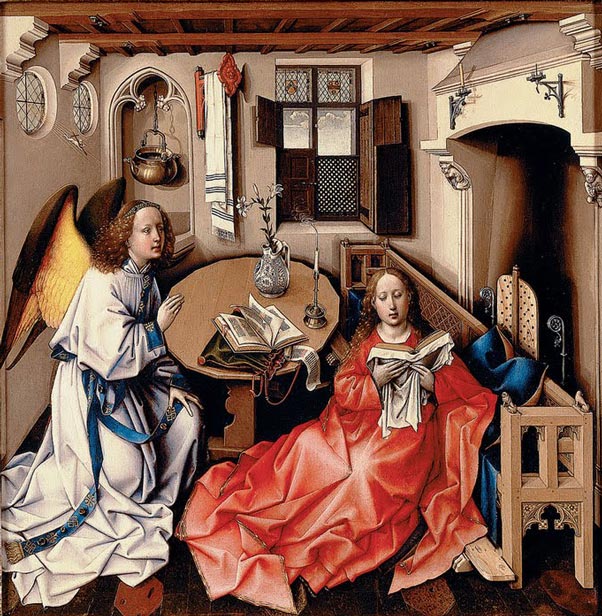
In any case, current prejudices mean that 15th-century Flemish painting is still accused of having ignored perspective.
It’s true, however, that at the end of the XIVth century, certain paintings by Melchior Broederlam (c. 1355-1411) and others by Robert Campin (1375-1444) (Master of Flémalle) show the viewer interiors where plates and cutlery on tables threaten to suddenly slide to the floor.
Nevertheless, it must be admitted that whenever the artist « ignores » or disregards the linear perspective scheme, he seems to do so more by choice than by incapacity. To achieve a limpid composition, the painter prioritizes his didactic mission to the detriment of all other considerations.
For example, in Campin’s Mérode Altarpiece, the exaggerated perspective of the table clearly shows that the vase is behind the candlestick and book.


Jan van Eyck’s Lam Gods (Mystic Lamb) in Ghent is another example.
Never could so many figures, with so much detail and presence, be shown with a linear perspective where the figures in the foreground would hide those behind. (NOTE 7)
But the intention to approximate a credible sense of space and depth remains.
If this perspective seems flawed by its linear geometry, Campin imposes an extraordinary sense of space through his revolutionary treatment of shadows. As every painter knows, light is painted by painting shadow.
In Campin’s work, every object and figure is exposed to several sources of light, generating a darker central shadow as the fruit of crossed shadows.
Van Eyck influenced by Arab Optics?

Roger Bacon, statue in Oxord.
This new treatment of light-space has been largely ignored. However, there are several indications that this new conception was partly the result of the influence of « Arab » science, in particular its work on optics.
Translated into Latin and studied from the XIIth century onwards, their work was developed in particular by a network of Franciscans whose epicenter was in Oxford (Robert Grosseteste, Roger Bacon, etc.) and whose influence spread to Chartres, Paris, Cologne and the rest of Europe.
It should be noted that Jan van Eyck (1395-1441), an emblematic figure of Flemish painting, was ambassador to Paris, Prague, Portugal and England.
I’ll briefly mention three elements that support this hypothesis of the influence of Arab science.
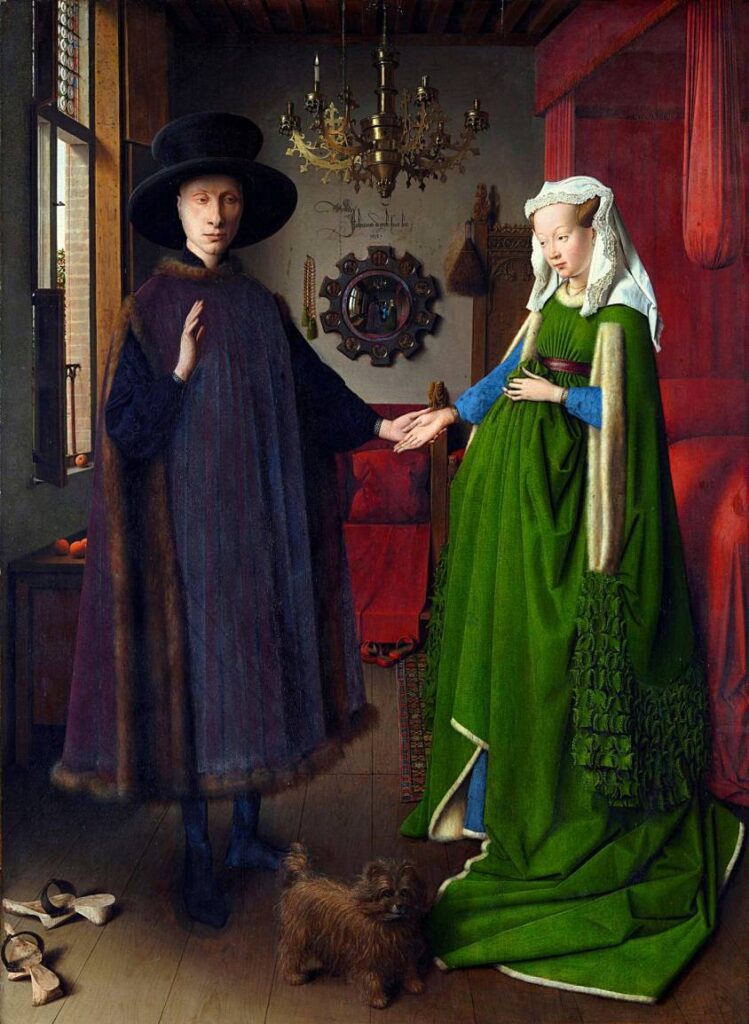
Curved mirrors
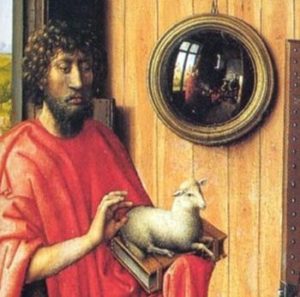
Robert Campin (master of Flémalle) in the Werl Triptych (1438) and Jan van Eyck in the Arnolfini portrait (1434), each feature convex mirrors of considerable size.
It is now certain that glaziers and mirror-makers were full members of the Saint Luc guild, the painters’ guild. (NOTE 8)
But it is relevant to know that Campin, now recognized as having run the workshop in Tournai where the painters Van der Weyden and Jacques Daret were trained, produced paintings for the Franciscans in this city. Heinrich Werl, who commissioned the altarpiece featuring the convex mirror, was an eminent Franciscan theologian who taught at the University of Cologne.

Artistic representation of Ibn Al-Haytam (Alhazen)
These convex and concave (or ardent) mirrors were much studied during the Arab renaissance of the IXth to XIth centuries, in particular by the Arab philosopher Al-Kindi (801-873) in Baghdad at the time of Charlemagne.
Arab scientists were not only in possession of the main body of Hellenic work on optics (Euclid‘s Optics, Ptolemy‘s Optics, the works of Heron of Alexandria, Anthemius of Tralles, etc.), but it was sometimes the rigorous refutation of this heritage that was to give science its wings.
After the decisive work of Ibn Sahl (Xth century), it was that of Ibn Al-Haytam (Latin name : Alhazen) (NOTE 9) on the nature of light, lenses and spherical mirrors that was to have a major influence. (NOTE 10)

As mentioned above, these studies were taken up by the Oxford Franciscans, starting with the English bishop of Lincoln, Robert Grosseteste (1168-1253).
In De Natura Locorum, for example, Grosseteste shows a diagram of the refraction of light in a spherical glass filled with water. And in his De Iride he marvels at this science which he connexts to perspective :
« This part of optics, so well understood, shows us how to make very distant things appear as if they were situated very near, and how we can make small things situated at a distance appear to the size we desire, so that it becomes possible for us to read the smallest letters from incredible distances, or to count sand, or grains, or any small object.«
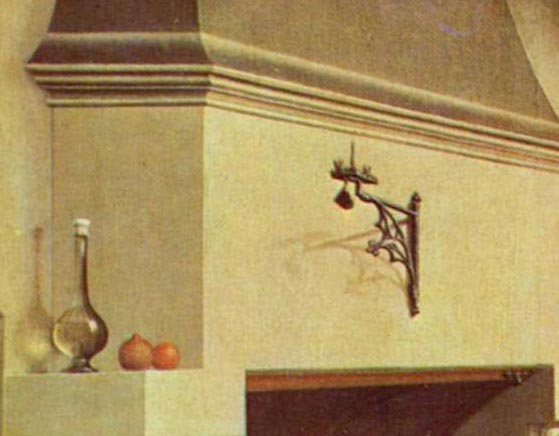
Grosseteste’s pupil Roger Bacon (1212-1292) wrote De Speculis Comburentibus, a specific treatise on « Ardent Mirrors » which elaborates on Ibn Al-Haytam‘s work.
Flemish painters Campin, Van Eyck and Van der Weyden proudly display their knowledge of this new scientific and technological revolution metamorphosed into Christian symbolisms.
Their paintings feature not only curved mirrors but also glass bottles, which they use as a metaphor for the immaculate conception.
A Nativity hymn of that period says:
« As through glass the ray passed without breaking it, so of the Virgin Mother, Virgin she was and virgin she remained… » (NOTE 11)
The Treatment of Light
In his Discourse on Light, Ibn Al-Haytam develops his theory of light propagation in extremely poetic language, setting out requirements that remind us of the « Eyckian revolution ». Indeed, Flemish « realism » and perspective are the result of a new treatment of light and color.
Ibn Al-Haytam:
« The light emitted by a luminous body by itself -substantial light- and the light emitted by an illuminated body -accidental light- propagate on the bodies surrounding them. Opaque bodies can be illuminated and then in turn emit light. »

This physical principle, theorized by Leonardo da Vinci, is omnipresent in Flemish painting. Just look at the images reflected in the helmet of St. George in Van Eyck‘s Madonna to Canon van der Paele (NOTE 12).
In each curved surface of Saint George’s helmet, we can identify the reflection of the Virgin and even a window through which light enters the painting.
The shining shield on St. George’s back reflects the base of the adjacent column, and the painter’s portrait appears as a signature. Only a knowledge of the optics of curved surfaces can explain this rendering.
Ibn Al-Haytam:
« Light can penetrate transparent bodies: water, air, crystal and their counterparts. »
And :
« Transparent bodies have, like opaque bodies, a ‘receiving power’ for light, but transparent bodies also have a ‘transmitting power’ for light.«
Isn’t the development of oil mediums and glazes by the Flemish an echo of this research? Alternating opaque and translucent layers on very smooth panels, the specificity of the oil medium alters the angle of light refraction.
In 1559, the painter-poet Lucas d’Heere referred to van Eyck‘s paintings as « mirrors, not painted scenes.«
Binocular perspective



Before the advent of « right » central linear perspective, art historians sought a coherent explanation for its birth in the presence of several seemingly disparate vanishing points by theorizing a so-called central « fishbone » perspective.
In this model, a number of vanishing lines, instead of coinciding in a single central vanishing point on the horizon, either end up in a « vanishing region » (NOTE 13), or align with what some call a vertical « vanishing axis », forming a kind of « fishbone ».
French Professor Dominique Raynaud, who worked for years on this issue, underscores that « all medieval treatises on perspective address the question of binocular vision », notably the Polish scholar Witelo (1230-1280) (NOTE 15) in his Perspectiva (I,27), an insight he also got from the works of Ibn Al-Haytam.
Witelo presents a figure to defend the idea that
« the two forms, which penetrate two homologous points of the surface of the two eyes, arrive at the same point of the concavity of the common nerve, and are superimposed at this point to become one » (Perspectiva, III, 37).
A similar line of reasoning can be found in Roger Bacon‘s Perspectiva Communis, written by John Pecham, Archbishop of Canterbury (1240-1290) for whom:
« the duality of the eyes must be reduced to unity »
So, as Professor Raynaud proposed, if we extend the famous vanishing lines (i.e., in our case, the « fish bones ») until they intersect, the « vanishing axis » problem disappears, as the vanishing lines meet. Interestingly, the result is a perspective with two vanishing points in the central region!

Suddenly, the diagrams drawn up to demonstrate the « empiricism » of the Flemish painters, if viewed from this point of view, reveal a legitimate construction probably based on optics as transmitted by Arab science and rediscovered by Franciscan networks and others.
Two paintings by Jan van Eyck clearly demonstrate that he followed this approach: The Madonna with Canon van der Paele of 1436 and the Dresden Tryptic of 1437.
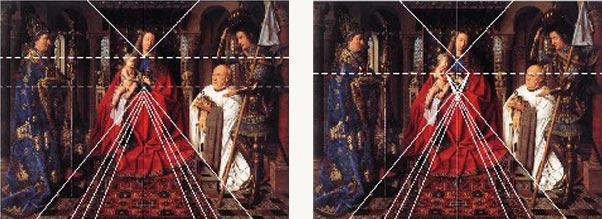

What seemed a clumsy, empirical approach in the form of a « fishbone » perspective (left) turns out to be a binocular perspective construction.
Was this type of perspective specifically Flemish?
A close examination of works by Ghiberti, Donatello and Paolo Uccello, generally dating from the first half of the XVth Century, reveals a mastery of the same principle.


Cusanus
But this whole demonstration is merely a look into the past through the eyes of modern scientific rationality. It would be a grave error not to take into account the immense influence of the Rhenish (Master Eckhart, Johannes Tauler, Heinrich Suso) and Flemish (Hadewijch of Antwerp, Jan van Ruusbroec, etc.) « mystics ».
This trend began to flourish again with the rediscovery of the Christianized neo-Platonism of Dionysius the Areopagite (Vth-VIth century), made accessible… by the new translations of the Franciscan Grosseteste in Oxford.
The spiritual vision of the Aeropagite, expressed in a powerful imagery language, is directly reminiscent of the metaphorical approach of the Flemish painters, for whom a certain type of light is simply the revelation of divine grace.
In On the Heavenly Hierarchy, Dionysius immediately presents light as a manifestation of divine goodness. It ennobles us and enables us to enlighten others:
« Let those who are illuminated be filled with divine clarity, and the eyes of their understanding trained to the work of chaste contemplation; finally, let those who are perfected, once their primitive imperfection has been abolished, share in the sanctifying science of the marvelous teachings that have already been manifested to them; similarly, let the purifier excel in the purity he communicates to others; let the illuminator, gifted with a greater penetration of spirit, equally fit to receive and transmit light, happily flooded with sacred splendor, pour it out in pressing streams on those who are worthy… » [Chap. III, 3]
Let’s think again of the St. George in Van Eyck‘s Madonna to Canon van der Paele, which indeed pours forth the multiple images of the Virgin who enlightens him.
This theo-philosophical trend reached full maturity in the work of Cardinal Nicolas of Cusa (Cusanus) (1401-1464) (NOTE 16), embodying the extremely fruitful encounter of this « negative theology » with Greek science, Socratic knowledge and Christian Humanism.

In contrast to both a science « without a hypothesis of God » and a metaphysics with an esoteric drift, an agapic love leads it to the education of the greatest number, to the defense of the weak and the humiliated.
The Brothers and Sisters of the Common Life, educating Erasmus of Rotterdam and inspiring Cusanus, are the best example of this.
But let’s sketch out some of Cusanus’ key ideas on painting.
In De Icona (The Vision of God) (1453), which he sent to the Benedictine monks of the Tegernsee, Cusanus condenses his fundamental work On Learned Ignorance (1440), in which he develops the concept of the coincidence of opposites. His starting point was a self-portrait of his friend « Roger », the Flemish painter Rogier van der Weyden, which he sent together with his sermon to the monks.
This self-portrait, like the multiple faces of Christ painted in the XVth century, uses an « optical illusion » to create the effect of a gaze that fixes the viewer, regardless of his or her position in front of the altarpiece.
In De Icona, written as a sermon, Cusanus asks monks to stand in a semicircle around the painting and watch this gaze pursue them as they move along the segment of the curve. In fact, he elaborates a pedagogical paradox based on the fact that the Greek name for God, Theos, has its etymological origin in the verb theastai (to see, to look at).
As you can see, he says, God looks at you personally, and his gaze follows you everywhere. He is therefore one and many. And even when you turn away from him, his gaze falls on you. So, miraculously, although he looks at everyone at the same time, he nevertheless establishes a personal relationship with each one. If « seeing » for God is « loving », God’s point of vision is infinite, omniscient and omnipotent love.

A parallel can be drawn here with the spherical mirror at the center of Jan van Eyck’s painting The Arnolfini portrait, painted in 1434, nineteen years before this sermon.
Firstly, this circular mirror is surrounded by the ten stations of Christ’s Passion, juxtaposed by a rosary, an explicit reference to God.
Secondly, it reveals a view of the entire room, an image that completely escapes the linear perspective of the foreground. A view comparable to the allcompassing « Vision of God » developed by Cusanus.
Finally, we see two figures in the mirror, but not the image of the painter behind his easel. These are undoubtedly the two witnesses to the wedding. Instead of signing his painting with « Van Eyck invent. », the painter signed his painting above the mirror with « Van Eyck was here » (NOTE 17), identifying himself as a witness.
As Dionysius the Aeropagite asserted:
« [the celestial hierarchy] transforms its adepts into so many images of God: pure and splendid mirrors where the eternal and ineffable light can shine, and which, according to the desired order, reflect liberally on inferior things this borrowed brightness with which they shine. » [Chap. III, 2]
The Flemish mystic Jan van Ruusbroec (1293-1381) evokes a very similar image in his Spiegel der eeuwigher salicheit (Mirror of eternal salvation) when he says:
« Ende Hi heeft ieghewelcs mensche ziele gescapen alse eenen levenden spieghel, daer Hi dat Beelde sijnre natueren in gedruct heeft. » (And he created each human soul as a living mirror, in which he imprinted the image of his nature).
And so, like a polished mirror, Van Eyck’s soul, illuminated and living in God’s truth, acts as an illuminating witness to this union. (NOTE 18)
So, although the Flemish painters of the XVth century clearly had a solid scientific foundation, they choose such or such perspective depending on the idea they wanted to convey.
In essence, their paintings remain objects of theo-philosophical speculation or as you like « intellectual prayer », capable of praising the goodness, beauty and magnificence of a Creator who created them in His own image. By the very nature of their approach, their interest lay above all in the geometry of a kind of « paradoxical space-light » capable, through enigma, of opening us up to a participatory transcendence, rather than simply seeking to « represent » a dead space existing outside metaphysical reality.
The only geometry worthy of interest was that which showed itself capable of articulating this non-linearity, a « divine » or « mystical » perspective capable of linking the infinite beauty of our commensurable microcosm with the immeasurable goodness of the macrocosm.
Thank you,
NOTES:
- Recently, Italian scholars have pointed to the role of Biagio Pelacani Da Parma (d. 1416), a professor at the University of Padua near Venice, in imposing such a perspective, which privileged only the « geometrical laws of the act of vision and the rules of mathematical calculation ».
- Erwin Panofsky, Perspective as Symbolic Form, p.41-42, Les Éditions de Minuit, Paris, 1975.
- Institut de France, Manuscrit E, 16 v° « the eye [h] perceives on the plane wall the images of distant objects greater than that of the nearer object. »
- Leonardo understands that Albertian perspective, like anamorphosis, condemns the viewer to a single, immobile point of vision.
- See, for example, the slight enlargement of the apostles at the ends of Leonardo da Vinci’s Last Supper in the Milan refectory.
- Baxandall, Bartholomaeus Facius on painting, Journal of the Warburg and Courtauld Institutes, 27, (1964). Fazio is also enthusiastic about a world map (now lost) by Jan van Eyck, in which all the places and regions of the earth are depicted recognizably and at measurable distances.
- To escape this fate, Pieter Bruegel the Elder used a cavalier perspective, placing his horizon line high up.
- Lionel Simonot, Etude expérimentale et modélisation de la diffusion de la lumière dans une couche de peinture colorée et translucide. Application à l’effet visuel des glacis et des vernis, p.9 (PhD thesis, Nov. 2002).
- Ibn Al-Haytam (Alhazen) (965-1039) wrote some 200 works on mathematics, astronomy, physics, medicine and philosophy. Born in Basra, after working on the development of the Nile in Egypt, he travelled to Spain. He is said to have carried out a series of highly detailed experiments on theoretical and experimental optics, including the camera obscura (darkroom), work that was later to feature in Leonardo da Vinci’s studies. Da Vinci may well have read the lengthy passages by Alhazen that appear in the Commentari of the Florentine sculptor Ghiberti. According to Gerbert d’Aurillac (the future Pope Sylvester II in 999), Bishop of Rheims, brought back from Spain the decimal system with its zero and an astrolabe, it was thanks to Gerard of Cremona (1114-c. 1187) that Europe gained access to Greek, Jewish and Arabic science. This scholar went to Toledo in 1175 to learn Arabic, and translated some 80 scientific works from Arabic into Latin, including Ptolemy’s Almagest, Apollonius’ Conics, several treatises by Aristotle, Avicenna‘s Canon, and the works of Ibn Al-Haytam, Al-Kindi, Thabit ibn Qurra and Al-Razi.
- In the Arab world, this research was taken up a century later by the Persian physicist Al-Farisi (1267-1319). He wrote an important commentary on Alhazen’s Treatise on Optics. Using a drop of water as a model, and based on Alhazen’s theory of double refraction in a sphere, he gave the first correct explanation of the rainbow. He even suggested the wave-like property of light, whereas Alhazen had studied light using solid balls in his reflection and refraction experiments. The question was now: does light propagate by undulation or by particle transport?
- Meiss, M., Light as form and symbol in some fifteenth century paintings, Art Bulletin, XVIII, 1936, p. 434.
- Note also the fact that the canon shows a pair of glasses…
- Brion-Guerry in Jean Pèlerin Viator, sa place dans l’histoire de la perspective, Belles Lettres, 1962, p. 94-96, states in obscure language that « the object of representation behaves most often in Van Eyck as a cubic volume seen from the front and from the inside. Perspectival foreshortening is achieved by constructing a rectangle whose sides form the base of four trapezoids. The orthogonals thus tend towards four distinct points of convergence, forming a ‘vanishing region' ».
- Dominique Raynaud, L’Hypothèse d’Oxford, essai sur les origines de la perpective, PUF, Paris 1998.
- Witelo was a friend of the Flemish Dominican scholar Willem van Moerbeke, a translator of Archimedes in contact with Saint Thomas Aquinas. Moerbeke was also in contact with the mathematician Jean Campanus and the Flemish neo-Platonic astronomer Hendrik Bate van Mechelen. Johannes Kepler‘s own work on human vision builds on that of Witelo.
- Cusanus was above all a man of science and theology. But he was also a political organizer. The painter Jan van Eyck fought for the same goals, as evidenced by the ecumenical theme of the Ghent polyptych. It shows the Mystic Lamb, symbolizing the sacrifice of the Son of God for the redemption of mankind, capable of reuniting a church torn apart by internal differences. Hence the presence of the three popes in the central panel, here united before the lamb. Van Eyck also painted a portrait of Cardinal Niccolo Albergati, one of the instigators of the great Ecumenical Council organized by Cusanus in Ferrara and then moved to Florence. If Cusanus called Van der Weyden « his friend Roger », it is also thought that Robert Campin may have met him, since he would have attended the Council of Basel, as did one of his commissioners, the Franciscan theologian Heinrich Werl.
- Jan Van Eyck was one of the first painters in the history of art to date and sign his paintings with his own name.
- Myriam Greilsammer’s book L’Envers du tableau, Mariage et Maternité en Flandre Médiévale (Editions Armand Colin, 1990) documents Arnolfini’s sexual escapades. Arnolfini was taken to court by one of his victims, a female servant. Van Eyck seems to have understood that the knightly Arnoult Fin, Lucchese financier and commercial representative of the House of Medici in Bruges, required the somewhat peculiar presence of the eye of the lord.
Avicenna and Ghiberti’s role in the invention of perspective during the Renaissance

By Karel Vereycken, Paris, France.
Same article in FR, même article en FR.

No visitor to Florence can miss the gilded bronze reliefs decorating the Porta del Paradiso (Gates of Paradise), the main gate of the Baptistery of Florence right in front of the Cathedral of Santa Maria del Fiore surmounted by Filippo Brunelleschi’s splendid cupola.

In this article, Karel Vereycken sheds new light on the contribution of Arab science and Ghiberti’s crucial role in giving birth to the Renaissance.

Historical context
The Baptistery, erected on what most Florentines thought to be the site of a Roman temple dedicated to the Roman God of Mars, is one of the oldest buildings in the city, constructed between 1059 and 1128 in the Florentine Romanesque style. The Italian poet Dante Alighieri and many other notable Renaissance figures, including members of the Medici family, were baptized in this baptistery.
During the Renaissance, in Florence, corporations and guilds competed for the leading role in design and construction of great projects with illustrious artistic creations.
While the Arte dei Lana (corporation of wool producers) financed the Works (Opera) of the Duomo and the construction of its cupola, the Arte dei Mercantoni di Calimala (the guild of merchants dealing in buying foreign cloth for finishing and export), took care of the Baptistery and financed the embellishment of its doors.
The Gates of Paradise
The Baptistry, an octagonal building, has four entrances (East, West, North and South) of which only three (South, North and East) have sets of artistically important bronze doors with relief sculptures. Three dates are key : 1329, 1401 and 1424.
- In 1329, the Calimala Guild, on Giotto‘s recommendation, ordered Andrea Pisano (1290-1348) to decorate a first set of doors (initialy installed as the East doors, i.e. seen when one leaves the Cathedral, but today South). These consist of 28 quatrefoil (clover-shaped) panels, with the 20 top panels depicting scenes from the life of St. John the Baptist (the patron of the edifice). The 8 lower panels depict the eight virtues of hope, faith, charity, humility, fortitude, temperance, justice, and prudence, praised by Plato in his Republic and represented during the XVIth century by the Flemish humanist painter and reader of Petrarch, Peter Brueghel the Elder. Construction took 8 years, from 1330 till 1338.
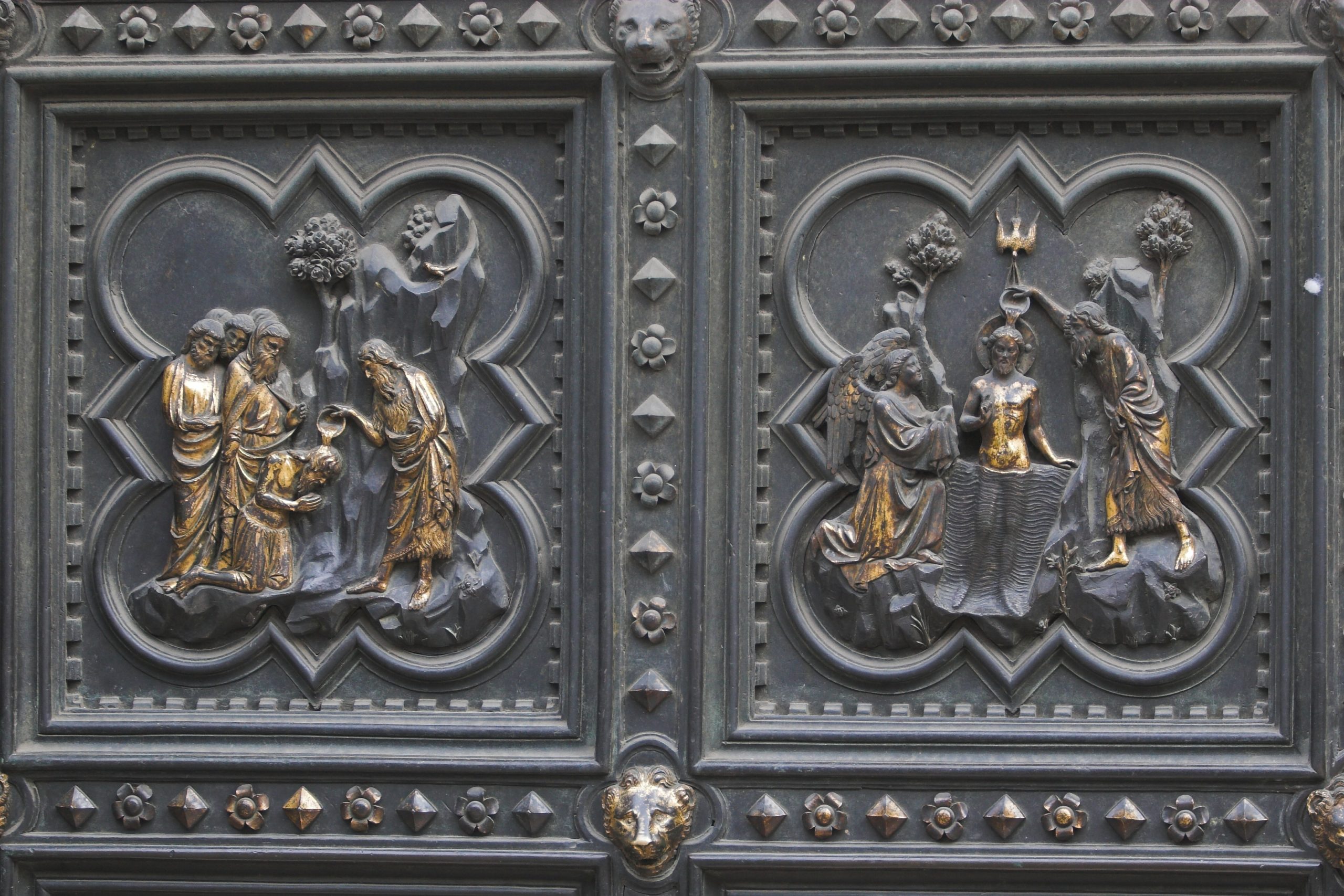
- In 1401, after having narrowly won the competition with Brunelleschi, the 23 year old and inexperienced young goldsmith Lorenzo Ghiberti (1378-1455), is commissioned by the Calima Guild to decorate the doors which are today the North Gate. Ghiberti cast the bronze high reliefs using a method known as lost-wax casting, a technique that he had to reinvent entirely since it was lost since the fall of the Roman Empire. One of the reasons Ghiberti won the contest, was that his technique was so advanced that it required 20 % less (7 kg per panel) bronze than that of his competitors, bronze being a dense material far more costly than marble. His technique, applied to the entire decoration of the North Gate, as compared to his competitors, would save some estimated 100 kg of bronze. And since in 1401, with the plague regularly hitting Florence, economic conditions were poor, even the wealthy Calimala took into account the total costs of the program.
The bronze doors are comprised of 28 panels, with 20 panels depicting the life of Christ from the New Testament. The 8 lower panels show the four Evangelists and the Church Fathers Saint Ambrose, Saint Jerome, Saint Gregory, and Saint Augustine. The construction took 24 years.
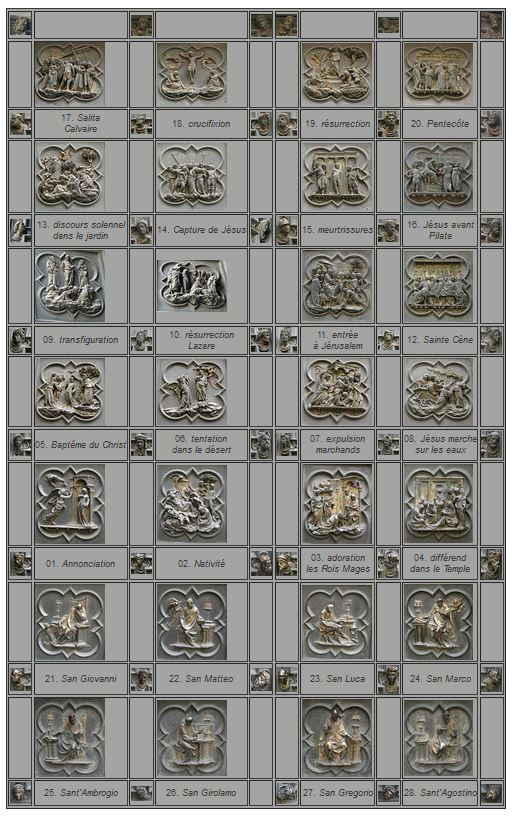

- In 1424, Ghiberti, at age 46, was given—unusually, with no competition—the task of also creating the East Gate. Only in 1452 did Ghiberti, then seventy-four years old, install the last bronze panels, since construction lasted this time 27 years! According to Giorgio Vasari (1511-1574), Michelangelo Buonarroti (1475-1564) later judged them « so beautiful they would grace the entrance to Paradise ».
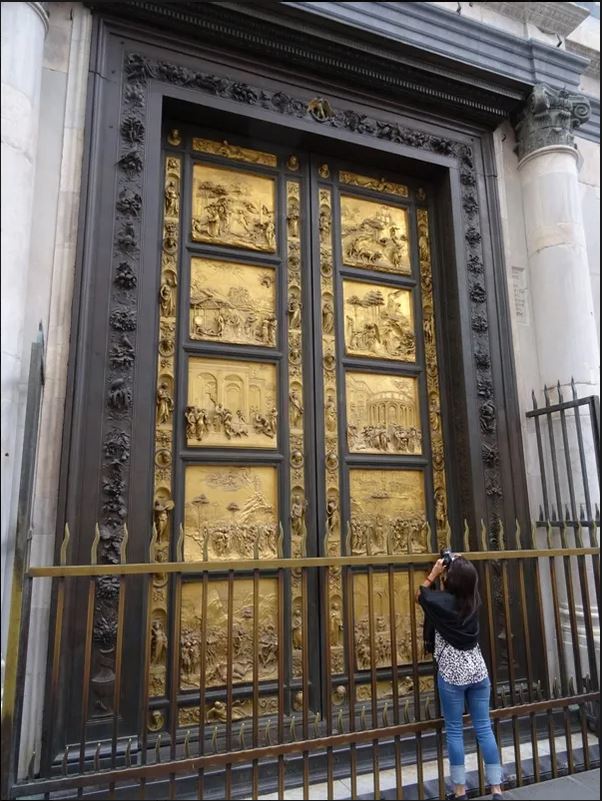
Over two generations, a bevy of well paid assistants and pupils were trained by Ghiberti, including exceptional artists, such as Luca della Robbia, Donatello, Michelozzo, Benozzo Gozzoli, Bernardo Cennini, Paolo Uccello, Andrea del Verrocchio and Ghiberti’s sons, Vittore and Tommaso. And over time, the seventeen-foot-tall, three-ton bronze doors became an icon of the Renaissance, one of the most famous works of art in the world.
In 1880, the French sculptor Auguste Rodin was inspired by it for his own Gates of Hell on which he worked for 38 year
Revolution

Of utmost interest for our discussion here is the dramatic shift in conception and design of the bronze relief sculptures that occurred between the North and the East Gates, because it reflects how bot the artist as well as his patrons used the occasion to share with the broader public their newest ideas, inventions and exciting discoveries.
The themes of the North Gate of 1401 were inspired by scenes from the New Testament, except for the panel made by Ghiberti, « The Sacrifice of Isaac », which had won him the selection competition the same year. To complete the ensemble, it was therefore only logical that the East Gate of 1424 would take up the themes of the Old Testament.
Originally, it was the scholar and former chancellor of Florence Leonardo Bruni (1369-1444) who planned an iconography quite similar to the two previous doors. But, after heated discussions, his proposal was rejected for something radically new. Instead of realizing 28 panels, it was decided, for aesthetic reasons, to reduce the number of panels to only 10 much larger square reliefs, between borders containing statuettes in niches and medallions with busts.

Hence, since each of the 10 chapters of the Old Testament contains several events, the total number of scenes illustrated, within the 10 panels has risen to 37 and all appear in perspective :
- Adam and Eve (The Creation of Man)
- Cain and Abel (Jalousie is the origin of Sin)
- Noah (God’s punishment)
- Abraham and Isaac (God is just)
- Jacob and Esau
- Joseph
- Moses
- Joshua
- David (Good commandor)
- Solomon and the Queen of Sheba
The general theme is that of salvation based on Latin and Greek patristic tradition. Very shocking for the time, Ghiberti places in the center of the first panel the creation of Eve, that of Adam appearing at the bottom left.
After the first three panels, focusing on the theme of sin, Ghiberti began to highlight more clearly the role of God the Savior and the foreshadowing of Christ’s coming. Subsequent panels are easier to understand. One example is the panel with Isaac, Jacob and Esau where the figures are merged with the surrounding landscape so that the eye is led toward the main scene represented in the top right.
Many of the sources for these scenes were written in ancient Greek, and since knowledge of Greek at that time was not so common, it appears that Ghiberti’s “theological advisor” was Ambrogio Traversari (1386-1439), with whom he had many exchanges.
Traversari was a close friend of Nicolas of Cusa (1401-1464), a protector of Piero della Francesca (1412-1492) and a key organizer of the Ecumenical Council of Florence of 1438-1439, which attempted to put an end to the schism separating the Church of the East from that of the West.
Perspective



The bronze reliefs, known for their vivid illusion of deep space in relief, are one of the revolutionary events that epitomize the Renaissance. In the foreground are figures in high relief, which gradually become less protruding thereby exploiting the full illusionistic potential of the stiacciato technique later brought to its high point by Donatello. Using this form of “inbetweenness”, they integrate in one single image, what appears both as a painting, a low relief as well as a high relief. Or maybe one has to look at it another way: these are flat images traveling gradually from a surface into the full three dimensions of life, just as Ghiberti, in one of the first self-portraits of art history, reaches his head out of a bronze medal to look down on the viewers. The artist desired much more than perspective, he wanted breathing space!
This new approach will influence Leonardo Da Vinci (1452-1517). As art historian Daniel Arasse points out :
(…) It was in connection with the practice of Florentine bas-relief, that of Ghiberti at the Gate of Paradise (…) that Leonardo invented his way of painting. As Manuscript G (folio 23b) would much later state, ‘the field on which an object is painted is a capital thing in painting. (…) The painter’s aim is to make his figures appear to stand out from the field’ – and not, one might add, to base his art on the alleged transparency of that same field. It is by the science of shadow and light that the painter can obtain an effect of emergence from the field, an effect of relief, and not by that of the linear perspective.
Donatello

At the beginning of the 15th century, several theoretical approaches existed and eventuall contradicted each other. Around 1423-1427, the talentful sculptor Donatello, a young collaborator of Ghiberti, created his Herod’s Banquet, a bas-relief in the stiacciato technique for the baptismal font of the Siena Baptistery.
In this work, the sculptor deploys a harmonious perspective with a single central vanishing point. Around the same time, in Florence, the painter Massacchio (1401-1428) used a similar construction in his fresco The Trinity.
As we will see, Ghiberti, starting from the anatomy of the eye, opposed such an abstract approach in his works as well as in his writings and explored, as early as 1401, other geometrical models, called « binocular ». (see below).

Christ among the Doctors, Ghiberti, before 1424.

Christ among the Doctors, Ghiberti, before 1424.
Then, as far as our knowledge reaches, in 1407, Brunelleschi had conducted several experiments on this question, most likely based on the ideas presented by another friend of Cusa, the Italian astronomer Paolo dal Pozzo Toscanelli (1397-1482), in the latter’s now lost treaty Della Prospettiva. What we do know is that Brunelleschi sought above all to demonstrate that all perspective is an optical illusion.
Finally, it was in 1435, that the humanist architect Leon Baptista Alberti (1406-1472), in his treatise Della Pictura, attempted, on the basis of Donatello’s approach, to theorize single vanishing point perspective as a representation of a harmonious and unified three-dimensional space on a flat surface. Noteworthy but frustrating for us today is the fact that Alberti’s treatise doesn’t contain any illustrations.

However, Leonardo, who read and studied Ghiberti’s writings on, would use the latter’s arguments to indicate the limits and even demonstrate the dysfunctionality of Alberti’s “perfect” perspective construction especially when one goes beyond a 30 degres angle.
In the Codex Madrid, II, 15 v. da Vinci realizes that « as such, the perspective offered by a rectilinear wall is false unless it is corrected (…) ».
Perspectiva artificialis versus perspectiva naturalis

Alberti’s “perspectiva artificialis” is nothing but an abstraction, necessary and useful to represent a rational organization of space. Without this abstraction, it is fairly impossible to define with mathematical precision the relationships between the appearance of objects and the receding of their various proportions on a flat screen: width, height and depth.
From the moment that a given image on a flat screen was thought about as the intersection of a plane cutting a cone or pyramid, a method emerged for what was mistakenly considered as an “objective” representation of “real” three dimensional space, though it is nothing but an “anamorphosis”, i.e. a tromp-l’oeil or visual illusion.
What has to be underscored, is that this construction does away with the physical reality of human existence since it is based on an abstract construct pretending:
- that man is a single eyed cyclops;
- that vision emanates from one single point, the apex of the visual pyramid;
- that the eye is immobile;
- that the image is projected on a flat screen rather than on a curved retina.
Slanders and gossip
The crucial role of Ghiberti, an artist which “Ghiberti expert” Richard Krautheimer mistakenly presents as a follower of Alberti’s perspectiva artificialis, has been either ignored or downplayed.
Ghiberti’s unique manuscript, the three volumes of the Commentarii, which include his autobiography and which established him as the first modern historian of the fine arts, is not even fully translated into English or French and was only published in Italian in 1998.
Today, because of his attention to minute detail and figures « sculpted » with wavy and elegant lines, as well as the variety of plants and animals depicted, Ghiberti is generally presented as “Gothic-minded”, and therefore “not really” a Renaissance artist!
Giorgio Vasari, often acting as the paid PR man of the Medici clan, slanders Ghiberti by saying he wrote « a work in the vernacular in which he treated many different topics but arranged them in such a fashion that little can be gained from reading it. »
Admittedly, tension among humanists, was not uncommon. Self-educated craftsmen, such as Ghiberti and Brunelleschi on the one side, and heirs of wealthy wool merchants, such as Niccoli on the other side, came from entirely different worlds. For example, according to a story told by Guarino Veronese in 1413, Niccoli greeted Filippo Brunelleschi haughtily: « O philosopher without books, » to which Filippo replied with his legendary irony: « O books without philosopher ».
For sure, the Commentarii, are not written according to the rhetorical rules of those days. Written at the end of Ghiberti’s life, they may have simply been dictated to a poorly trained clerk who made dozens of spelling errors.
The humanists

The Commentarii does reveal a highly educated author and a thinker having profound knowledge of many classical Greek and Arab thinkers. Ghiberti was not just some brilliant handcraft artisan but a typical “Renaissance man”.
In dialogue with Bruni, Traversari and the “manuscript hunter” Niccolo Niccoli, Ghiberti, who couldn’t read Greek but definitely knew Latin, was clearly familiar with the rediscovery of Greek and Arab science, a task undertaken by Boccaccio’s and Salutati’s “San Spirito Circle” whose guests (including Bruni, Traversari, Cusa, Niccoli, Cosimo di Medici, etc.) later would convene every week at the Santa Maria degli Angeli convent. Ghiberti exchanges moreover with Giovanni Aurispa, a collaborator of Traversari who brought back from Byzantium, years before Bessarion, the whole of Plato’s works to the West.
Amy R. Bloch, in her well researched study Lorenzo Ghiberti’s Gates of Paradise, Humanism, History, and Artistic Philosophy in the Italian Renaissance (2016), writes that « Traverari and Niccoli can be tied directly to the origins of the project for the Gates and were clearly interested in sculptural commissions being planned for the Baptistery. On June 21, 1424, after the Calima requested from Bruni his program for the doors, Traversari wrote to Niccoli acknowledging, in only general terms, Niccoli’s ideas for the stories to be included and mentioning, without evident disapproval, that the guild had instead turned to Bruni for advice. »
Palla Strozzi
Ghiberti’s patron, sometimes advisor, and close associate was Palla Strozzi (1372-1462), who, besides being the the richest man in Florence with a gross taxable assets of 162,925 florins in 1427, including 54 farms, 30 houses, a banking firm with a capital of 45,000 florins, and communal bonds, was also a politician, a writer, a philosopher and a philologist whose library contained close to 370 volumes in 1462.
Just as Traversari and Bruni, Strozzi learned Latin and studied Greek under the direction of the Byzantine scholar Manuel Chrysoloras, invited to Florence by Salutati.
Ghiberti’s close relationship with Strozzi, writes Bloch, « gave him access to his manuscripts and, as importantly, to Strozzi’s knowledge of them. »
But there was more. « The relationship between Ghiberti and Palla Strozzi was so close that, when Palla went to Venice in 1424 as one of two Florentine ambassadors charged with negociating an alliance with the Venetians, Ghiberti accompanied him in his retinue. »
Strozzi was known as a real humanist, always looking to preserve peace while strongly opposing oligarchical rule, both in Florence as in Venice.
In fact it was Palla Strozzi, not Cosimo de’ Medici, who first set in motion plans for the first public library in Florence, and he intended for the sacristy of Santa Trinita to serve as its entryway. While Palla’s library was never realized due to the dramatic political conflict knows as the Albizzi Coup that led to his exile in 1434, Cosimo who got a free hand to rule over Florence, would make the library project his own.
A bold statement
Ghiberti begins the Commentarii with a bold and daring statement for a Christian man in a Christian world, about how the art of antiquity came to be lost:
The Christian faith was victorious in the time of Emperor Constantine and Pope Sylvester. Idolatry was persecuted to such an extent that all the statues and pictures of such nobility, antiquity an perfection were destroyed and broken in to pieces. And with the statues and pictures, the theoretical writings, the commentaries, the drawing and the rules for teaching such eminent and noble arts were destroyed.
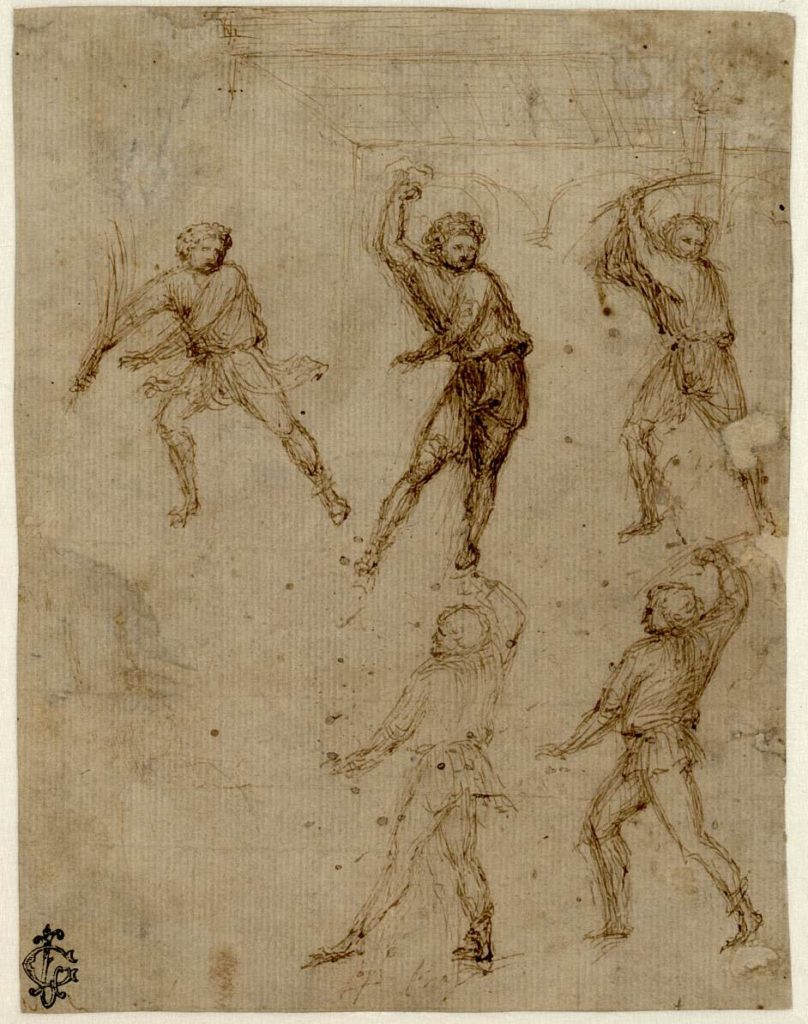
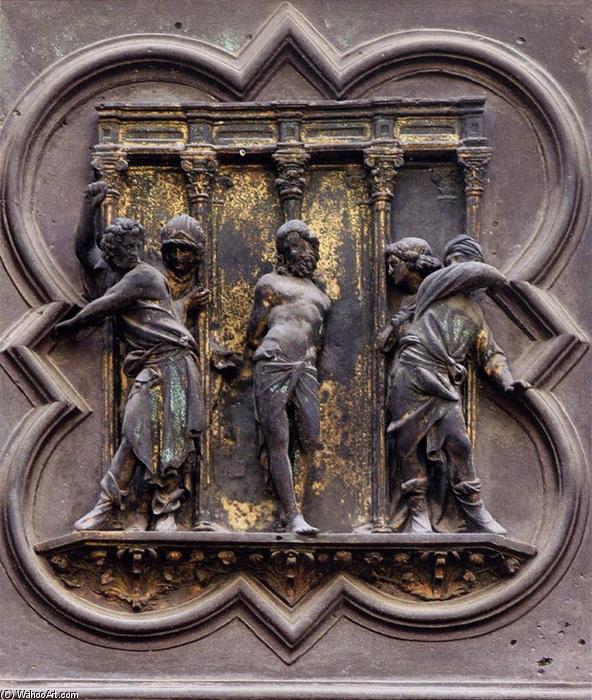

Ghiberti understood the importance of multidisciplinarity for artists. According to him, “sculpture and painting are sciences of several disciplines nourished by different teachings”.
In book I of his Commentarii, Ghiberti gives a list of the 10 liberal arts that the sculptor and the painter should master : philosophy, history, grammar, arithmic, astronomy, geometry, perspective, theory of drawing, anatomy and medecine and underlines that the necessity for an artist to assist at anatomical dissections.
As Amy Bloch underscores, while working on the Gates, in the intense process of visualizing the stories of God’s formation of the world and its living inhabitants, Ghiberti’s engagement « stimulated in him an interest in exploring all types of creativity — not only that of God, but also that of nature and of humans — and led him to present in the opening panel of the Gates of Paradise (The creation of Adam and Eve) a grand vision of the emergence of divine, natural, and artistic creation. »

The inclusion of details evoking God’s craftmanship, says Bloch, « recalls similes that liken God, as the maker of the world, to an architect, or, in his role as creator of Adam, to a sculptor or painter. Teh comparison, which ultimately derives from the architect-demiurge who creates the world in Plato’s Timaeus, appears commonly in medieval Jewish and Christian exegesis. »
Philo of Alexandria wrote that man was modeled « as by a potter » and Ambrose metaphorically called God a « craftsman (artifex) and a painter (pictor) ». Consequently, if man is « the image of God » as says Augustine and the model of the « homo faber – man producer of things », then, according to Salutati, « human affairs have a similarity to divine ones ».
The power of vision and the composition of the Eye
Concerning vision, Ghiberti writes:
I, O most excellent reader, did not have to obey to money, but gave myself to the study of art, which since my childhood I have always pursued with great zeal and devotion. In order to master the basic principles I have sought to investigate the way nature functions in art; and in order that I might be able to approach her, how images come to the eye, how the power of vision functions, how visual [images] come, and in what way the theory of sculpture and painting should be established.
Now, any serious scholar, having worked through Leonardo’s Notebooks, who then reads Ghiberti’s I Commentarii, immediately realizes that most of Da Vinci’s writings were basically comments and contributions about things said or answers to issues raised by Ghiberti, especially respecting the nature of light and optics in general. Leonardo’s creative mindset was a direct outgrowth of Ghiberti’s challenging world outlook.

In Commentario 3, 6, which deals with optics, vision and perspective, Ghiberti, opposing those for whom vision can only be explained by a purely mathematical abstraction, writes that “In order that no doubt remains in the things that follow, it is necessary to consider the composition of the eye, because without this one cannot know anything about the way of seeing.” He then says, that those who write about perspective don’t take into account “the eye’s composition”, under the pretext that many authors would disagree.
Ghiberti regrets that despite the fact that many “natural philosophers” such as Thales, Democritus, Anaxagoras and Xenophanes have examined the subject along with others devoted to human health such as “Hippocrates, Galen and Avicenna”, there is still so much confusion.
Indeed, he says, “speaking about this matter is obscure and not understood, if one does not have recourse to the laws of nature, because more fully and more copiously they demonstrate this matter.”
Avicenna, Alhazen and Constantine
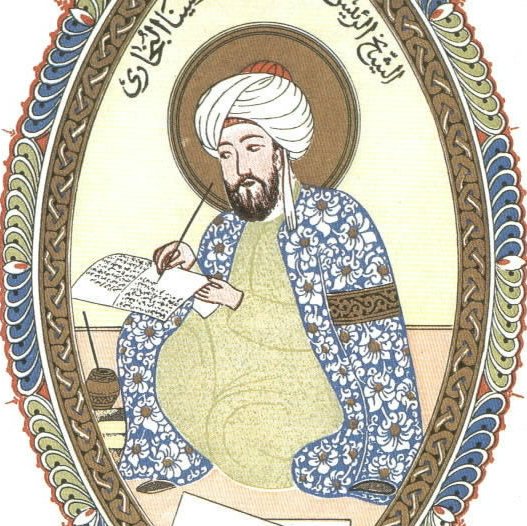
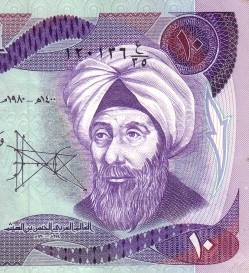
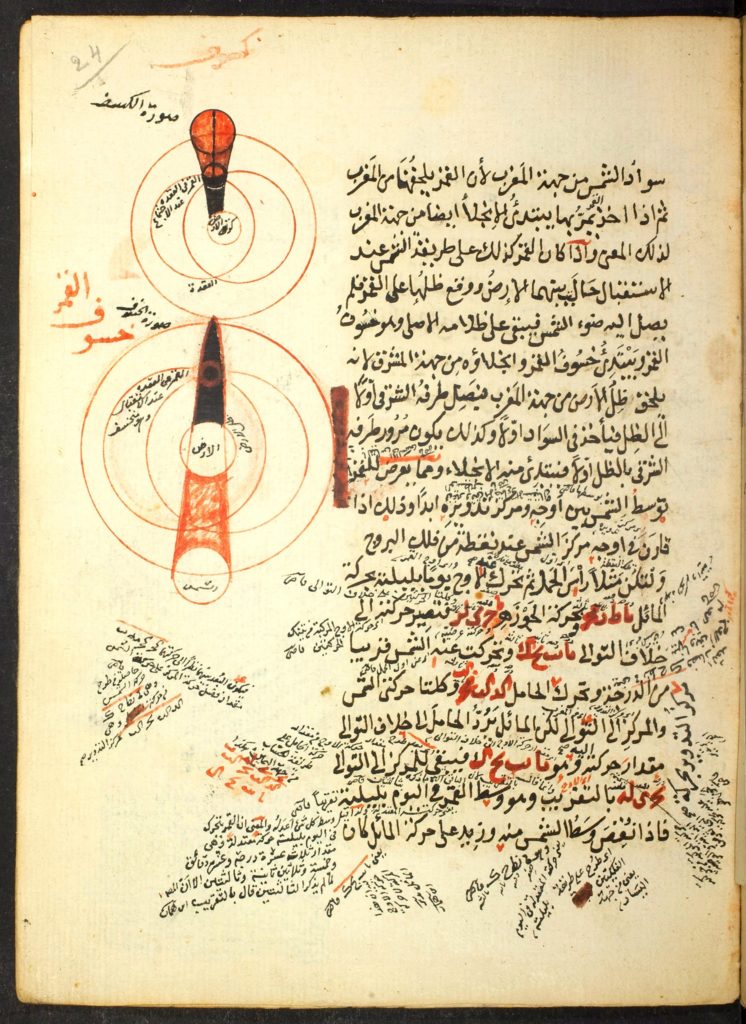
Therefore, says Ghiberti:
it is necessary to affirm some things that are not included in the perspective model, because it is very difficult to ascertain these things but I will try to clarify them. In order not to deal superficially with the principles that underlie all of this, I will deal with the composition of the eye according to the writings of three authors, Avicenna (Ibn Sina), in his books, Alhazen (Ibn al Haytham) in his first volume on perspective (Optics), and Constantine (the Latin name of the Arab scholar and physician Qusta ibn Luqa) in his ‘First book on the Eye’; for these authors suffice and deal with much certainty in these subjects that are of interest to us.
This is quite a statement! Here we have “the” leading, founding figure of the Italian and European Renaissance with its great contribution of perspective, saying that to get any idea about how vision functions, one has to study three Arab scientists: Ibn Sina, Ibn al Haytham and Qusta ibn Luqa ! Cultural Eurocentrism might be one reason why Ghiberti’s writings were kept in the dark.
Ibn al-Haytham (Alhazen) made important contributions to opthalmology and improved upon earlier conceptions of the processes involved in vision and visual perception in his Treatise on Optics (1021), which is known in Europe as the Opticae Thesaurus. Following his work on the camera oscura (darkroom) he was also the first to imagine that the retina (a curved surface), and not the pupil (a point) could be involved in the process of image formation.
Avicenna, in the Canon of Medicine (ca. 1025), describes sight and uses the word retina (from the Latin word rete meaning network) to designate the organ of vision.
Later, in his Colliget (medical encyclopedia), Ibn Rushd (Averroes, 1126-1198) was the first to attribute to the retina the properties of a photoreceptor.
Avicenna’s writings on anatomy and medical science were translated and circulating in Europe since the XIIIth century, Alhazen’s treatise on optics, which Ghiberti quotes extensively, had just been translated into Italian under the title De li Aspecti.
It is now recognized that Andrea del Verrocchio, whose best known pupil was Leonardo da Vinci (1452-1517) was himself one of Ghiberti’s pupils. Unlike Ghiberti, who mastered Latin, neither Verrocchio nor Leonardo mastered a foreign language.
What is known is that while studying Ghiberti’s Commentarii, Leonardo had access in Italian to a series of original quotations from the Roman architect Vitruvius and from Arab scientists such as Avicenna, Alhazen, Averroes and from those European scientists who studied Arab optics, notably the Oxford Fransciscans Roger Bacon (1214-1294), John Pecham (1230-1292) and the Polish monk working in Padua, Erazmus Ciolek Witelo (1230-1275), known by his Latin name Vitellion.

As stressed by Professor Dominque Raynaud, Vitellion introduces the principle of binocular vision for geometric considerations.
He gives a figure where we see the two eyes (a, b) receiving the images of points located at equal distance from the hd axis.
He explains that the images received by the eyes are different, since, taken from the same side, the angle grf (in red) is larger than the angle gtf (in blue). It is necessary that these two images are united at a certain point in one image (Diagram).
Where does this junction occur? Witelo says: « The two forms, which penetrate in two homologous points of the surface of the two eyes, arrive at the same point of the concavity of the common nerve, and are superimposed in this point to become one ».
The fusion of the images is thus a product of the internal mental and nervous activity.
The great astronomer Johannes Kepler (1571-1630) will use Alhazen’s and Witelo’s discoveries to develop his own contribution to optics and perspective. “Although up to now the [visual] image has been [understood as] a construct of reason,” Kepler observes in the fifth chapter of his Ad Vitellionem Paralipomena (1604), “henceforth the representations of objects should be considered as paintings that are actually projected on paper or some other screen.” Kepler was the first to observe that our retina captures an image in an inverted form before our brain turns it right side up.
Out of this Ghiberti, Uccello and also the Flemish painter Jan Van Eyck, in contact with the Italians, will construct as an alternative to one cyclopic single eye perspective revolutionary forms of “binocular” perspective while Leonardo and Louis XI’ court painter Jean Fouquet will attempt to develop curvilinear and spherical space representations.
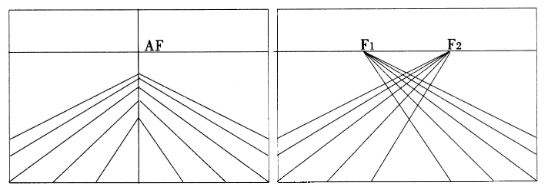

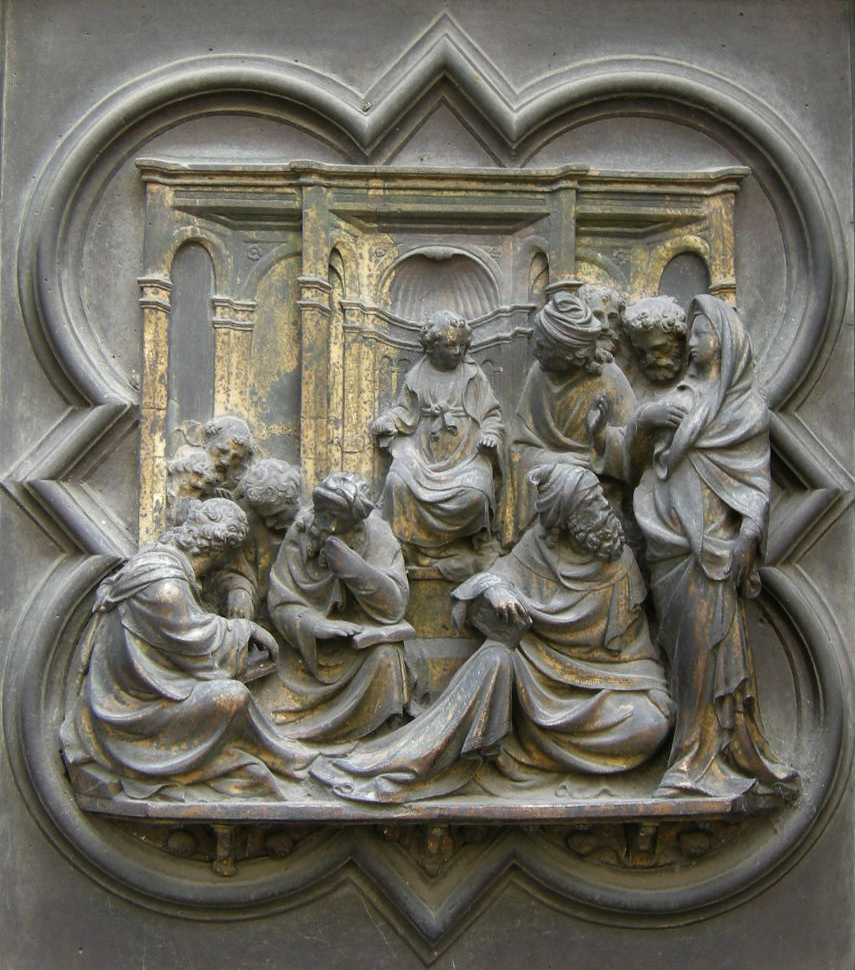

In China, eventually influenced by Arab optical science breakthrough’s, forms of non-linear perspective, that integrate the mobility of the eye, will also make their appearance during the Song Dynasty.
Light
Ghiberti will add another dimension to perspective: light. One major contribution of Alhazen was his affirmation, in his Book of Optics, that opaque objects struck with light become luminous bodies themselves and can radiate secondary light, a theory that Leonardo will exploit in his paintings, including in his portraits.
Already Ghiberti, in the way he treats the subject of Isaac, Jacob and Esau (Figure), gives us an astonishing demonstration of how one can exploit that physical principle theorized by Alhazen. The light reflected by the bronze panel, will strongly differ according to the angle of incidence of the arriving rays of light. Arriving either from the left of from the right side, in both cases, the Ghiberti’s bronze relief has been modeled in such a way that it magnificently strengthens the overall depth effect !

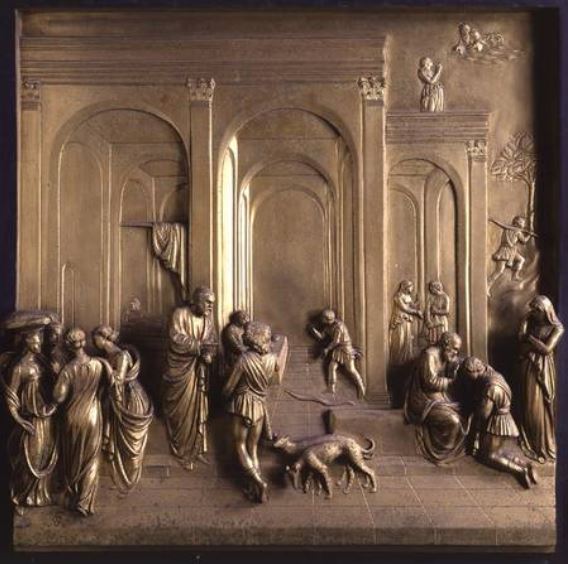
While the experts, especially the neo-Kantians such as Erwin Panofsky or Hans Belting, say that these artists were “primitives” because applying the “wrong” perspective model, they can’t grasp the fact that they were in reality exploring a far “higher domain” than the mere pure mathematical abstraction promoted by the Newton-Galileo cult that became the modern priesthood ruling over “science”.
Much more about all of this can and should be said. Today, the best way to pay off the European debt to “Arab” scientific contributions, is to reward not just the Arab world but all future generations with a better future by opening to them the “Gates of Paradise”.
See all of Ghiberti’s works at the WEB GALLERY OF ART
Short Biography
- Arasse, Daniel, Léonard de Vinci, Hazan, 2011;
- Avery, Charles, La sculpture florentine de la Renaissance, Livre de poche, 1996, Paris;
- Belting, Hans, Florence & Baghdad, Renaissance art and Arab science, Harvard University Press, 2011;
- Bloch, Amy R., Lorenzo Ghiberti’s Gates of Paradise; Humanism, History and Artistic Philosophy in the Italian Renaissance, Cambridge University Press, 2016, New York;
- Borso, Franco et Stefano, Uccello, Hazan, Paris, 2004 ;
- Butterfield, Andrew, Verrocchio, Sculptor and painter of Renaissance Florence, National Gallery, Princeton University Press, 2020 ;
- Butterfield, Andrew, Art and Innovation in Ghiberti’s Gates of Paradise, High Museum of Art, Yale University Press, 2007;
- Kepler, Johannes, Paralipomènes à Vitellion, 1604, Vrin, 1980, Paris;
- Krautheimer, Richard and Trude, Lorenzo Ghiberti, Princeton University Press, New Jersey, 1990;
- Martens, Maximiliaan, La révolution optique de Jan van Eyck, dans Van Eyck, Une révolution optique, Hannibal – MSK Gent, 2020.
- Pope-Hennessy, John, Donatello, Abbeville Press, 1993 ;
- Radke, Gary M., Lorenzo Ghiberti: Master Collaborator; The Gates of Paradise, Lorenzo Ghiberti’s Renaissance Masterpiece, High Museum of Atlanta and Yale University Press, 2007;
- Rashed, Roshi, Geometric Optics, in History of Arab Sciences, edited by Roshdi Rashed, Vol. 2, Mathematics and physics, Seuil, Paris, 1997.
- Raynaud, Dominique, L’hypothèse d’Oxford, essai sur les origines de la perspective, PUF, 1998, Paris.
- Raynaud, Dominique, Ibn al-Haytham on binocular vision: a precursor of physiological optics, Arabic Sciences and Philosophy, Cambridge University Press (CUP), 2003, 13, pp. 79-99.
- Raynaud, Dominique, Perspective curviligne et vision binoculaire. Sciences et techniques en perspective, Université de Nantes, Equipe de recherche: Sciences, Techniques, et Sociétés, 1998, 2 (1), pp.3-23.;
- Vereycken, Karel, interview with People’s Daily: Leonardo Da Vinci’s « Mona Lisa » resonates with time and space with traditional Chinese painting, 2019.
- Vereycken, Karel, Uccello, Donatello, Verrocchio and the art of military command, 2022.
- Vereycken, Karel, The Invention of Perspective, Fidelio, 1998.
- Vereycken, Karel, Van Eyck, un peintre flamand dans l’optique arabe, 1998.
- Vereycken, Karel, Mutazilism and Arab astronomy, two bright stars in our firmament, 2021.
- Walker, Paul Robert, The Feud That Sparked the Renaissance, How Brunelleschi and Ghiberti changed the World, HarperCollins, 2002.
Uccello, Donatello, Verrocchio and the art of military command

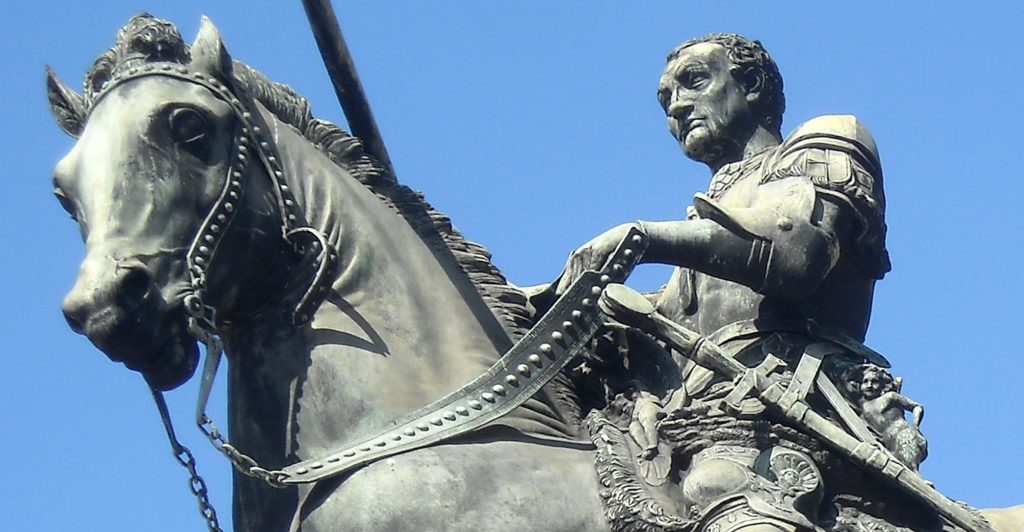
Uccello, Donatello, Verrocchio and the art of military command. An inquiry into the key events and artistic achievements that created the Renaissance. By Karel Vereycken, Paris.
Prologue

If there is still a lot to say, write and learn about the great geniuses of the European Renaissance, it is also time to take an interest in those whom the historian Georgio Vasari condescendingly called « transitional figures ».
How can one measure the contributions of Pieter Bruegel the Elder without knowing Pieter Coecke van Aelst? How can we value Rembrandt’s work without knowing Pieter Lastman? How did Raphaelo Sanzio innovate in relation to his master Perugino?
In 2019, an exceptional exhibition on Andrea Del Verrocchio (1435-1488), at the National Gallery in Washington, D.C., highlighted his great achievements, truly inspiring outbursts of great beauty that his pupil Leonardo da Vinci (1452-1519) would theorize and put to his greatest advantage.
The sfumato of Leonardo ? Verrochio is the pioneer, especially in the blurred features of portraits of women made with mixed techniques (pencil, chalk and gouache).

The joy of discovery
Leafing through the catalog of this exhibition, my joy got immense when I discovered (and to my knowledgne nobody else seems to have made this observation before me) that the enigmatic angel the viewer’s eye meets in Leonardo’s painting titled The Virgin on the Rocks (1483-1486) (Louvre, Paris), besides the movement of the body, is grosso modo a visual “quote” of the image of a terra cotta high relief (Louvre, Paris) attributed to Verrochio and “one of his assistants”, possibly even Leonardo himself, since the latter was training with the master as early as age seventeen ! The finesse of its execution and drapery also reminds us of the only known statue of Da Vinci, The Virgin with the laughing Child.

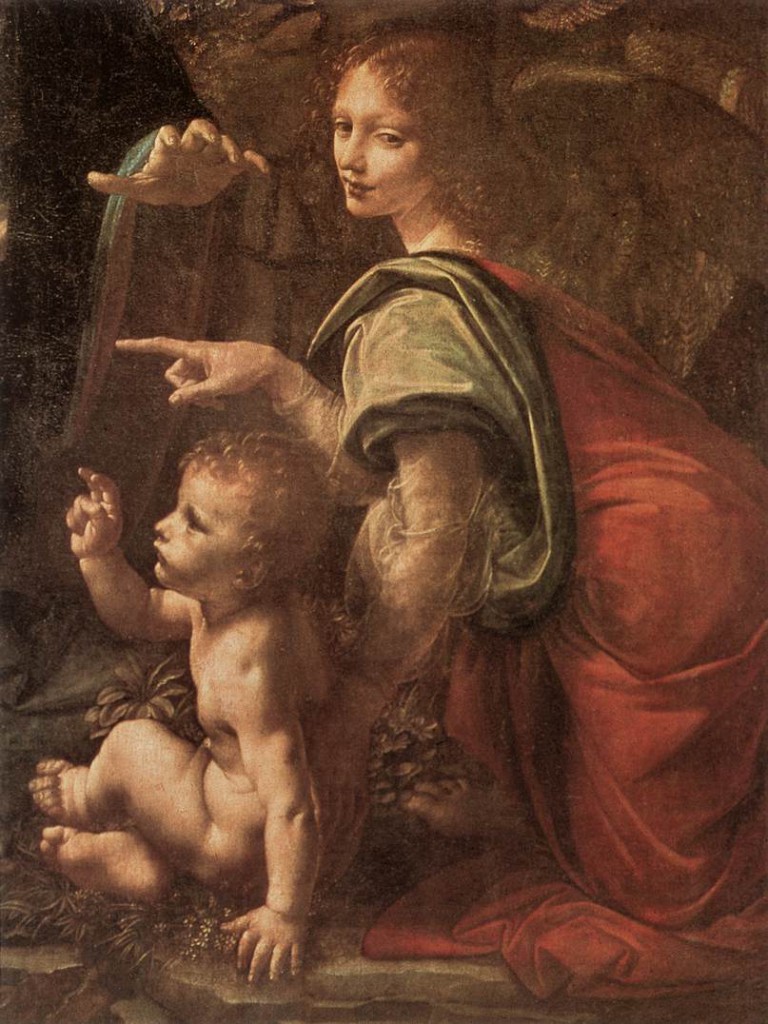
Many others made their beginnings in Verrocchio’s workshop, notably Lorenzo de Credi, Sandro Botticelli, Piero Perugino (Raphael’s teacher) and Domenico Ghirlandaio (Michelangelo’s teacher).
Coming out of the tradition of the great building sites launched in Florence by the great patron of the Renaissance, Cosimo de Medici for the realization of the doors of the Baptistery and the completion of the dome of Florence by Philippo Brunelleschi (1377-1446), Verrocchio conceived his studio as a true “polytechnic” school.
In Florence, for the artists, the orders flowed in. In order to be able to respond to all requests, Verrocchio, initially trained as a goldsmith, trained his students as craftsman-engineer-artists: drawing, calculation, interior decoration, sculpture, geology, anatomy, metal and woodworking, perspective, architecture, poetry, music and painting. A level of freedom and a demand for creativity that has unfortunately long since disappeared.
The Ghiberti legacy
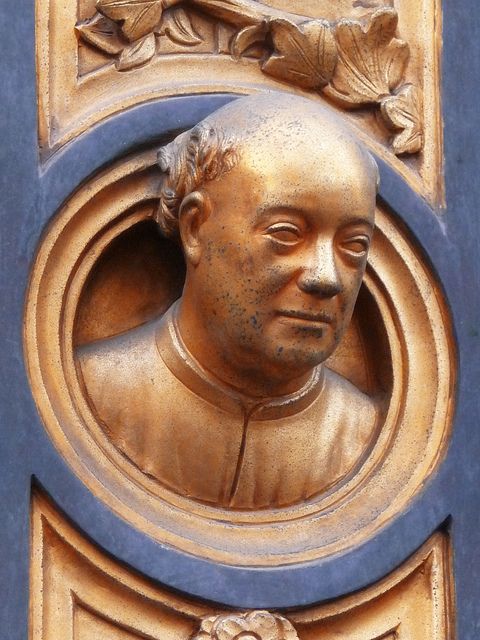
In painting, Verrocchio is said to have begun with the painter Fra Filippo Lippi (1406-1469). As for the bronze casting trade, he would have been, like Donatello, Masolino, Michelozzo, Uccello and Pollaiuolo, one of the apprentices recruited by Lorenzo Ghiberti (1378-1455) whose workshop, starting from 1401, over forty years, will be in charge of casting the bronze bas-reliefs of two of the huge doors of the Baptistery of Florence.
Others suggest that Verrocchio was most likely trained by Michelozzo, the former companion of Ghiberti who said up shop with Donatello. As a teenager, Donatello had accompanied Brunelleschi on their joint expeditions to Rome to investigate the legacy of Greek and Roman art, and not only the architectural legacy.
In reality, Verrocchio only perpetuated and developed the model of Ghiberti’s « polytechnic » studio, where he learned the art. An excellent craftsman, Ghiberti was also goldsmith, art collector, musician and humanist scolar and historian.
His genius is to have understood the importance of multidisciplinarity for artists. According to him « sculpture and painting are sciences of several disciplines nourished by different teachings ».
The ten disciplines that he considered important to train artists are grammar, philosophy, history, followed by perspective, geometry, drawing, astronomy, arithmetic, medicine and anatomy.
You can discover, says Ghiberti, only when you managed to isolate the object of your research from interfering factors, and you can discover by detaching oneself from a dogmatic system;
as the nature of things want it, the sciences hidden under artifices are not constituted so that the men with narrow chests can judge them.
Anticipating the type of biomimicry that will characterize Leonardo thereafter, Ghiberti affirms that he sought:
to discover how nature functioned and how he could approach it to know how the objects come to the eye, how the sight functions and in which way one has to practice sculpture and painting.
Ghiberti, who was familiar with some of the leading members of the circle of humanists led by Salutati and Traversari, based his own reflexions on optics on the authority of ancient texts, especially Arabic. He wrote:
But in order not to repeat in a superficial and superfluous way the principles that found all opinions, I will treat the composition of the eye particularly according to the opinions of three authors, namely Avicenna [Ibn Sina], in his books, Alhazen [Ibn al Haytam], in the first book of his perspective, and Constantine [Qusta ibn Luqa] in the first book on the eye; for these authors are sufficient and treat with more certainty the things that interest us.
Deliberately ignored (but copied) by Vasari, Ghiberti’s Commentaries are a real manuel for artists, written by an artist. Most interestingly, it is by reading Ghiberti’s Commentaries that Leonardo da Vinci became familiar with important Arab contributions to science, in particular the outstanding work of Ibn al Haytam (Alhazen) whose treatise on optics had just been translated from Latin into Italian under the title De li Aspecti, and is quoted at length by Ghiberti in his Commentario Terzio. Author A. Mark Smith suggests that, through Ghiberti, Alhazen’s Book of Optics
may well have played a central role in the development of artificial perspective in early Renaissance Italian painting.

Ghiberti’s comments are not extensive. However, for the pupils of his pupil Verrocchio, such as Leonardo, who didn’t command any foreign language, Ghiberti’s book did make available in italian a series of original quotes from the roman architect Vitruvius, arab scientists such as Alhazen), Avicenna, Averroes and those european scientists having studied arab optics, notably the Oxford fransciscans Roger Bacon, John Pecham and the Polish monk working in Padua, Witelo.
Finally, in 1412, Ghiberti, while busy coordinating all the works on the Gates of the Baptistry, was also the first Renaissance sculptor to cast a life-size statue in bronze, his Saint John the Baptist, to decorate Orsanmichele, the house of the Corporations in Florence.
Lost wax casting
However, in order to cast bronzes of such a size, the artists, considering the price of metal, would use the technique known as “lost wax casting”.

This technique consists of first making a model in refractory clay (A), covered with a thickness of wax corresponding to the thickness of the bronze thought necessary.
The model is then covered with a thick layer of wet plaster (B) which, as it solidifies, forms an outer mold. Finally, the very hot molten bronze, pored into the mold it penetrates by rods (J) provided for this purpose, will replace the wax.
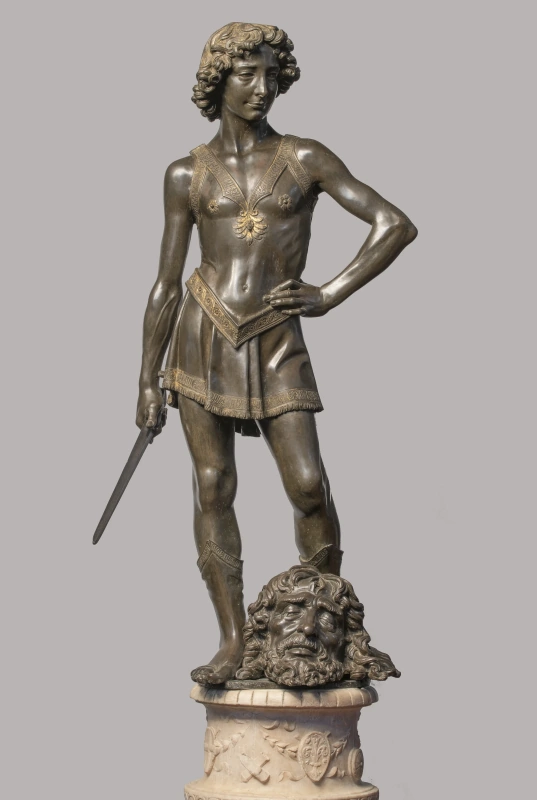
Finally, once the metal has solidified, the coating is broken. The details of the bronze (K) are then adjusted and polished (L) according to the artist’s choice.
This technique would become crucial for the manufacture of bells and cannons. While it was commonly used in Ifé in Africa in the 12th century for statuary, in Europe it was only during the Renaissance, with the orders received by Ghiberti and Donatello, that it was entirely reinvented.
In 1466, after the death of Donatello, it was Verrocchio’s turn to become the Medici’s sculptor in title for whom he produced a whole series of works, notably, after Donatello, his own David in bronze (Bargello National Museum, Florence).
If with this promotion his social ascendancy is certain, Verrocchio found himself facing the greatest challenge that any artist of the Renaissance could have imagined: how to equal or even surpass Donatello, an artist whose genius has never been praised enough?
Equestrian art
This being said, let us now approach the subject of the art of military command by comparing four equestrian monuments:
- Roman Emperor Marcus Aurelius on the Capitoline square in Rome (175 AD) ;
- Paolo Uccello’s fresco of John Hawkwood in the church of Santa Maria del Fiore in Florence (1436);
- Erasmo da Narni, known as “Gattamelata” (1446-1450), casted by Donatello in Padua.
- Bartolomeo Colleoni by Andrea del Verrocchio in Venice (1480-1488).
Equestrian statues appeared in Greece in the middle of the 6th century B.C. to honor the victorious riders in a race. From the Hellenistic period onward, they were reserved for the highest state figures, sovereigns, victorious generals and magistrates. In Rome, on the forum, they constituted a supreme honor, subject to the approval of the Senate. Apart from being bronze equestrian statues, each one is placed in a place where their troops fought.
While each statue is a reminder of the importance of military and political command, the way in which this responsibility is exercised is quite different.
Marcus Aurelius in Rome

Marcus Aurelius was born in Rome in 121 A.D., into a noble family of Spanish origin. He was the nephew of the emperor Hadrian. After the death of Marcus Aurelius’ father, Hadrian entrusted him to his successor Antonin. The latter adopts and gives him an excellent education. He was initiated early in philosophy by his master Diognetus.
Interested in the stoics, he adopted for a while their lifestyle, sleeping on the ground, wearing a rough tunic, before he was dissuaded by his mother.
He went to Athens in 175 A.D. and became a promotor of philosophy. He helps financially the philosophers and the rhetoricians by granting them a fixed salary. Concerned with pluralism, he supported the Platonic Academy, the Lyceum of Aristotle, the Garden of Epicurus and the Stoic Portico.
On the other hand, during his reign, persecutions against Christians were numerous. He saw them as troublemakers – since they refused to recognize the Roman gods, and as fanatics.

Erected in 175 A.D., the statue was entirely gilded. Its location in antiquity is unknown, but in the Middle Ages it stood in front of the Basilica of St. John Lateran, founded by Constantine, and the Lateran Palace, then the papal residence.
In 1538, Pope Paul III had the monument of Marcus Aurelius transferred to the Capitol, the seat of the city’s government. Michelangelo restored the statue and redesigned the square around it, one of the fanciest in Rome. It is undoubtedly the most famous equestrian statue, and above all the only one dating back to ancient Rome that has survived, the others having been melted down into coins or weapons…
If the statue survived, it is thanks to a misunderstanding: it was thought that it represented Constantine, the first Roman emperor to have converted to Christianity at the beginning of the 4th century, and it was out of the question to destroy the image of a Christian ruler.
Neither the date nor the circumstances of the commission are known.
But the presence of a defeated enemy under the right foreleg of the horse (attested by medieval testimonies and since lost), the emperor’s gesture and the shape of the saddle cloth, unusual in the Roman world, make us to belief that the statue commemorated Marcus Aurelius’ victories, perhaps on the occasion of his triumph in Rome in 176, or even after his death. Indeed, his reign (161-180) was marked by incessant wars to counter the incursions of Germanic or Eastern peoples on the borders of an Empire that was now threatened and on the defensive.
The horse, while not that large, but looking powerful, has been sculpted with great care and represented with realism. Its nostrils are strongly dilated, its lips pulled by the bit reveal its teeth and tongue.
One leg raised, he has just been stopped by his rider, who holds the reins with his left hand. Like him, the horse turns his head slightly to the right, a sign that the statue was made to be seen from that side. Part of his harness is preserved, but the reins have disappeared.
The size of the athletic rider nevertheless dominates that of a powerful horse that he rides without stirrups (accessories unknown to the Romans). He is dressed in a short tunic belted at the waist and a ceremonial cloak stapled on the right shoulder. It is a civil and not a military garment, adapted to a peaceful context. He is wearing leather shoes held together by intertwined straps.
The statue is striking for its size (424 cm high) and for the majesty it exudes. Without armor or weapons, eyes wide open and without emotion, the emperor raises his right arm. His authority derives above all from the function he embodies: he is the Emperor who protects his Empire and his people by punishing their enemies without mercy.
The fresco by Paolo Uccello
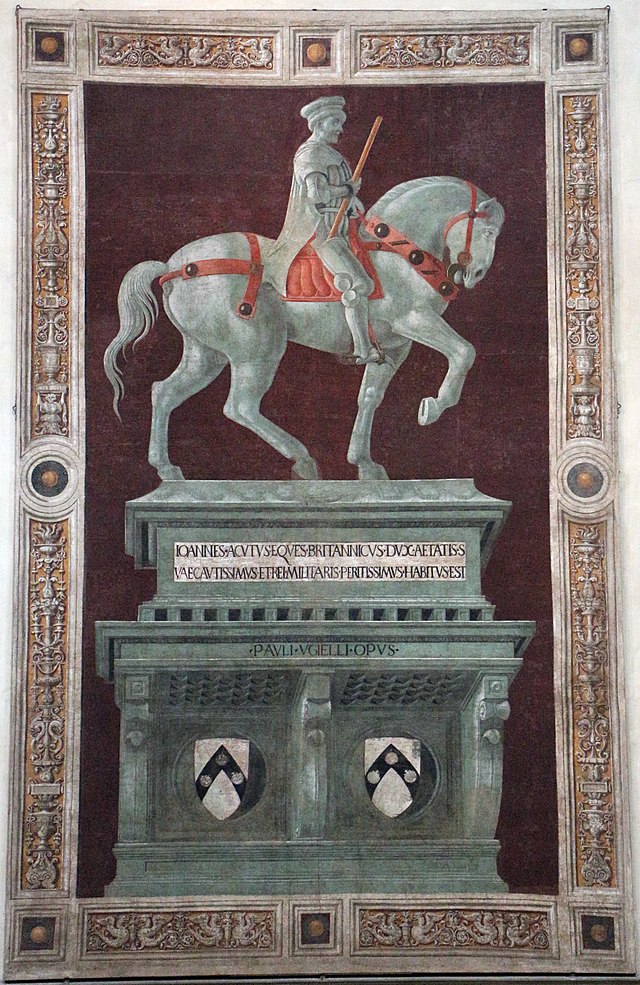
In 1436, at the request of Cosimo de’ Medici, the young Paolo Uccello was commissioned to paint a fresco depicting John Hawkwood (1323-1394), the son of an English tanner who had become a warlord during the Hundred Years’ War in France and whose name would be Italicized into Giovanno Acuto.
Serving the highest bidder, especially rival Italian cities, Hawkwood’s company of mercenaries was no slouch.
In Florence, although it may seem paradoxical, it was the humanist chancellor Coluccio Salutati (1331-1406) who put Hawkwood at the head of a regular army in the service of the Signoria.
This approach is not unlike that of Louis XI in France, who, in order to control the skinners and other cutthroats who were ravaging the nation, did not hesitate to discipline them by incorporating them into a standing army, the new royal army.
The humanists of the Renaissance, notably Leonardo Bruni (1370-1440) in his De Militia (1420), became aware of the curse of using mercenaries in conflicts and of the fact that only standing army, i.e. a permanent army formed of professionals and even better by citizens and maintained by a state or a city could guarantee a lasting peace.
Although Hawkwood faithfully protected the city for 18 years, his ugly “professionalism” as a mercenary was not unanimously accepted, to the point of inspiring the proverb “Inglese italianato è un diavolo Incarnato” (« An Italianized Englishman is a devil incarnate »).
Petrarch denounced him, Boccaccio tried in vain to mount a diplomatic offensive against him, St. Catherine of Sienna begged him to leave Italy, Chaucer met him and, no doubt, used him as a model for The Knight’s Tale (The Canterbury Tales).
All this will not prevent Cosimo, a member of the humanist conspiracy and a great patron of the arts, returning from exile, from wanting to honor him. But in the absence of the bronze equestrian statue (which had been promised to him…), Florence, will only offer him a fresco in the nave of Santa Maria del Fiore, that is to say under right under the cupola of the Duomo.

From the very beginning, Paolo Uccello’s fresco seems to have stirred quite a controversy. A preparatory drawing in the collections of Florence’s Uffizi Museum indicates the commander, more armed, taller, and, with his horse in a more military position. Uccello had originally depicted Hawkwood as « more threatening », with his baton raised and horse « at the ready ».
A recent ultraviolet study confirms the fact that the painter had originally depicted the condottiere armed from head to toe. In the final version, he wears a sleeveless jacket, the giornea, and a coat; only his legs and feet are protected by a piece of armor. The final version presents a less imposing rider, less warlike, more human and more individualized
In the dispute, it was not Uccello who was considered faulty, but his sponsors. Moreover, the painter was quickly given the task of redoing the fresco in a way deemed “more appropriate”.

Unfortunately, there is no record of the debates that must have raged among the officials of the church fabric (Opera Del Domo). What is certain is the fact that in the final version, visible today, the condottiere has been transformed from a warlord running a gang of mercenaries, into the image of philosopher-king whose only weapon is his commanding staff. At the bottom of the fresco, we can read in Latin: “Giovanno Acuto, British knight, who was in his time held as a very prudent general and very expert in military affairs.”
The position of the horse and the perspective of the sarcophagus have been changed from a simple profile to a di sotto in su view.
If this perspective is somewhat surrealistic and the pose of the horse, raising both legs on the same side, simply impossible, it remains a fact that Uccello’s fresco will set “the standards” of the ideal and impassive image of virtue and command that must embody the hero of the Renaissance: his goal is no longer to “win” a war (the objective of the mercenary), but to preserve the peace by preventing it (the objective of a philosopher-king or simply a wise head of state).
Paradigm shift


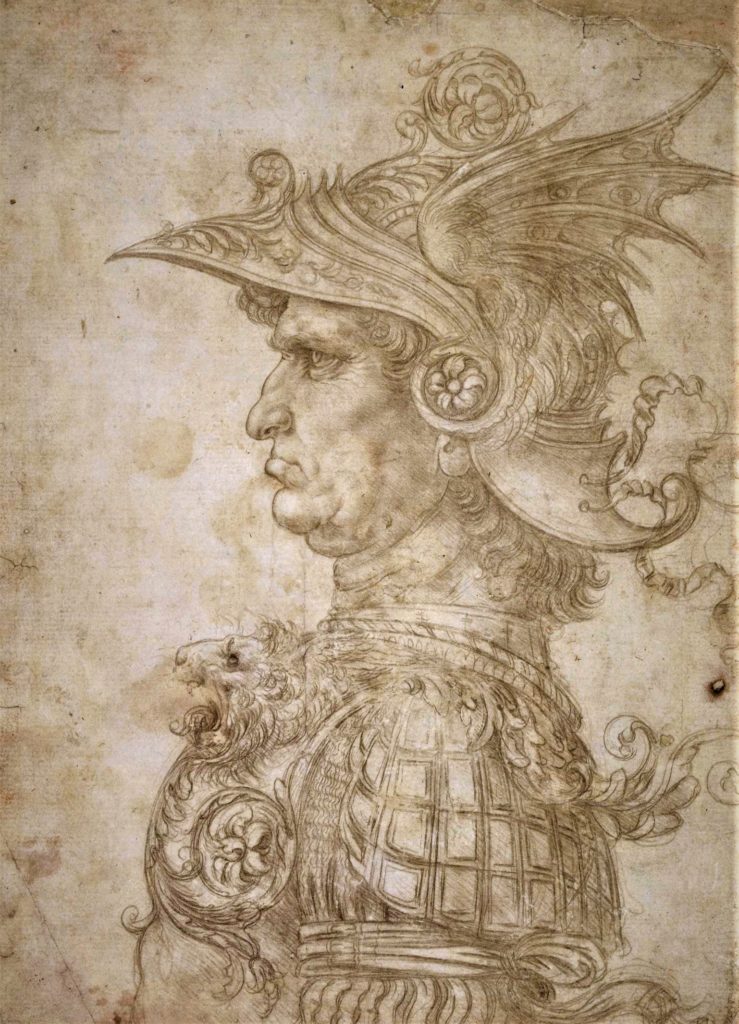
As such, one might say that Uccello’s fresco announces the “paradigm shift” marking the end of the age of perpetual feudal wars, to that of the Renaissance, that is to say to that of a necessary concord between sovereign nation-states whose security is indivisible, the security of one being the guarantee of the security of the other, a paradigm even more rigorously defined in 1648 at the Peace of Westphalia, when it made the agapic notion of the “advantage of the other” the basis of its success.
One historian suggests that the recommissioning of Uccello’s fresco was part of the « refurbishing » of the cathedral associated with its rededication as Santa Maria del Fiore by the humanist Pope Eugene IV in March 1436, determined to convince the Eastern and Western Churches to peacefully overcome their divisions and réunite as was attempted at the Council of Florence of 1437-1438 and for which the Duomo was central.
Interesting is the fact that Uccello’s fresco appeared at around the same time that Yolande d’Aragon and Jacques Coeur, who had his Italian connections, persuaded the French king Charles VII to put an end to the Hundred Years’ War by setting up a permanent, standing army.
In 1445, an ordinance was passed to discipline and rationalize the army in the form of cavalry units grouped into Compagnies d’Ordonnances, the first permanent army at the disposal, not of warlords or aristocrats, but of the King of France.
Donatello’s “Gattamelata” (1447-1453)

It was only some years later, in Padua, between 1447 and 1453, that Donatello would work on the statue of Erasmo da Narni (1370-1443), a Renaissance condottiere, i.e. the leader of a professional army in the service of the Republic of Venice, which at the time ruled the city of Padua. An important detail is that Erasmo was nicknamed “il Gattamelata”.
In French, « faire la chattemite » means to affect a false air of sweetness to deceive or seduce… Others explain that his nickname of “honeyed cat” comes from the fact that his mother was called Melania Gattelli or that he wore a crest (a helmet) in the shape of a honey-colored cat in battle…
The man was of humble origin, the son of a baker, born in Umbria around 1370. He learned to handle weapons from Ceccolo Broglio, lord of Assisi, and then, when he was in his thirties, from the captains of Braccio da Montone, who was known for recruiting the best fighters.
In 1427, Erasmo, who had the confidence of Cosimo de’ Medici, signed a seven-year contract with the humanist Pope Martin V, who wished to strengthen an army corps loyal to his cause with the aim of bringing to heel the lords of Emilia, Romagna and Umbria who were rebellious against papal authority.

He bought a huge suit of armor to reinforce his high stature. He was not an impetuous fighter, but a master of siege warfare, which forced him to take slow, thoughtful and progressive action. He spied on his prey for a long time before trapping it.
In 1432, he captured the fortress of Villafranca near Imola by cunning alone and without fighting. The following year he did the same to capture the fortified town of Castelfranco, thus sparing his soldiers and his treasure.
Those who were unable to grasp his tactics, accused him of being a coward for “running away” from the front-line, not realizing, that on a given moment, this was part of the tactics of his winning strategy.
He was a prudent captain, with a very well-mannered troop, and he was careful to maintain good relations with the magistrates of the towns that employed him. He obtained the rank of captain-general of the army of the Republic of Venice during the fourth war against the Duke of Milan in 1438 and died in Padua in 1443. Following his death, the Venetian Republic gave him full honors and Giacoma della Leonessa, his widow, commissioned a sculpture in honor of her late husband for 1650 ducats.
The statue, which represents the life-size condottiere, in antique-style armor and bareheaded, holding his commanding staff in his raised right hand, on his horse, was made by the lost-wax method. As early as 1447, Donatello made the models for the casting of the horse and the condottiere. The work progresses at full speed and the work is completed in 1453 and placed on its pedestal in the cemetery that adjoins the Basilica of Padua.

Brilliant for his cunning and guile, Gattamelata was a thoughtful and effective fighter in action, the type of leader recommended by Machiavelli in The Prince, and which appears in the sixteenth century by François Rabelais in his account of the “Picrocholine wars”.
Not the brute power of weapons, but the cunning and the intelligence will be the major qualities that Donatello will make appear powerfully in his work.
Contrary to Marcus Aurelius, it is not his social status that gives the commander his authority, but his intelligence and his creativity in the government of the city and the art of war. Donatello had an eye for detail. Looking at the horse, we see that it is a massive animal but far from static. It has a slow and determined gait, without any hesitation.
But that’s not all. A rigorous analysis shows that the proportions of the horse are of a “higher order” than those of the condottiere. Did Donatello make a mistake and make Erasmo too small and the horse too large? No, the sculptor made this choice to emphasize the value of Gattamelata who, thanks to his skills, is able to tame even wild and gigantic animals. In addition, the horse’s eyes show him as wild and untameable. Looking at him, one could say that it is impossible to ride him, but Gattamelata manages it with ease and without effort.
Because if you look at the reins in the hands of the protagonist, you will notice that he holds them in complete tranquility. This is another detail that highlights Erasmus’ powerful cunning and ingenuity.
Next, did you notice that one of the horse’s legs rests on a sphere? If this sphere (which could also be a cannonball, since Erasmus was a warrior) serves to give stability to Donatello’s composition as a whole, it also indicates how this animal of gigantic strength (symbolizing here warlike violence), once tamed and well used, allows the globe (the earthly kingdom) to be kept in balance.
Having told you about the horse, it is time to know more about the condottiere.
He has a proud and determined expression. The baton of command, which he holds in his hand, delicately touches the horse’s mane. The baton is not just a symbolic object; he may have received it in 1438 from the Republic of Venice.
Unlike Uccello’s fresco, Gattamelata is not dressed as a contemporary prince of commander, but as a figure beyond time embodying both the past, the present and the future. To capture this, Donatello, who takes care of every detail, has taken an ancient model and modernized it with incredible results. The details of the protagonist’s armor include purely classical motifs such as the head of Medusa, taken from Marcus Aurelius, in Greek mythology one of the three gorgons whose eyes had the power to petrify any mortal who crossed her gaze.
Although the helmet of Gattamelata would have allowed to identify him at eyesight, Donatello has discarded this option. With a helmet on his head, he would have been the symbol of a bloodthirsty warrior, rather than a cunning man. Even better, the absence of a helmet allows the artist to show us a fearless commander whose fixed gaze shows his determination. With the figure slightly bowed and legs extended, the sword in its scabbard placed at an angle, Donatello gives the illusion of an “imbalance” that reinforces in the viewer’s mind the idea that the horse is advancing with full strength.
Art historian John Pope-Hennessy is emphatic:
The fundamental differences between the Gattamelata and Marcus Aurelius are obvious. The (roman) emperor sits passively on his horse, legs dangling. In the fifteenth century, on the other hand, the art of riding implies the use of spurs. The impression of authority that emanates from the monument designed by Donatello comes from the total domination of the condottiere over his horse. (…) The soles of the feet are exactly parallel to the surface of the pedestal, as are the large six-pointed spurs, stretched to the middle of the animal’s flank.
As a result, Gattamelata is not a remake of the “classical Greek or Roman sculpture” of a hero with a sculpted physique, but a kind of new man who succeeds through reason. The fact that the statue has such a high pedestal also has its reason. Placed at such a height, the Gattamelata does not “share” our own space. It is in another dimension, eternal and out of time.
Verrocchio’s Colleoni

Some thirty years later, between 1480 and 1488, Andrea del Verrocchio, after a contest, was selected to make a large bronze equestrian statue of another Italian condottiere named Bartolomeo Colleoni (1400-1475).
A ruthless mercenary, working for a patron one day and his rival the next day, he served from 1454 the Republic of Venice with the title of general-in-chief (capitano generale). He died in 1475 leaving a will in which he bequeathed part of his fortune to Venice in exchange for the commitment to erect a bronze statue to his honor in St. Mark’s Square.
The Venetian Senate agreed to erect an equestrian monument to his memory, while charging the costs to the widow of the deceased…
In addition, the Senate refused to erect it in St. Mark’s Square, which was, along with St. Mark’s Basilica, at the heart of the city’s life. The Senate therefore decided to interpret the conditions set by Colleoni in his last will and testament without contradicting them, choosing to erect his statue in 1479, not in St. Mark’s Square, but in an area further from the city center in front of the Scuola San Marco, on the campo dei Santi Giovanni e Paolo.
Although Verrocchio had started working on the project since 1482, it remained unfinished at his death in 1488. And it is, not as Verrocchio wished, his heir Lorenzo di Credi who will cast the statue, but the Venetian Alessandro Leopardi (who lost the contest to Verrocchio), who will not hesitate to sign it!
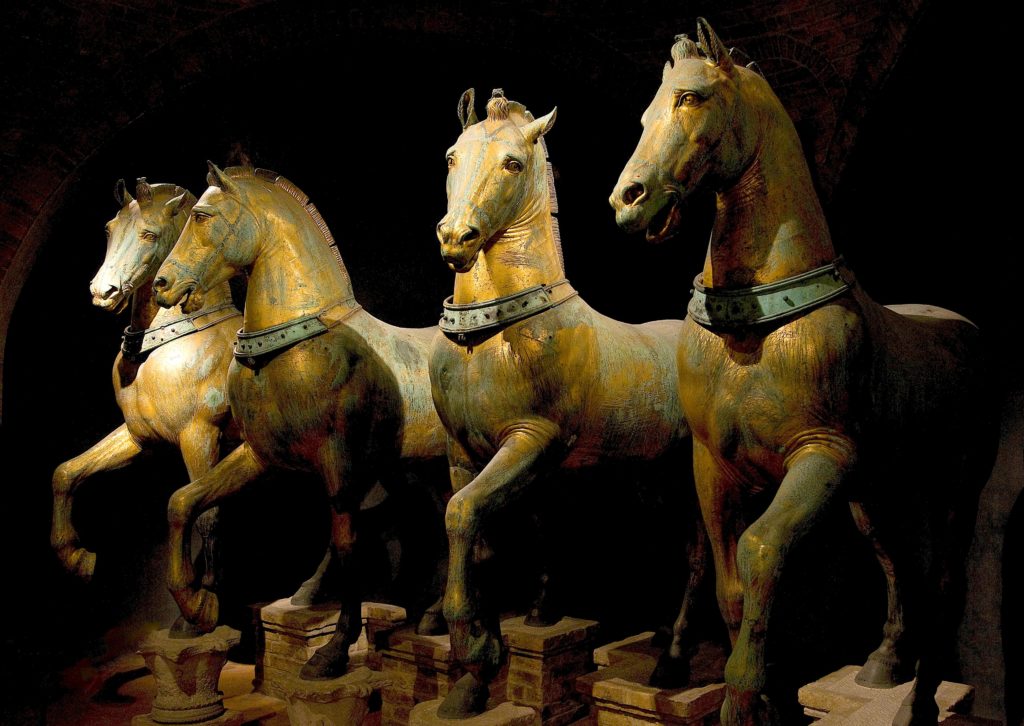
If the horse is in conformity with the typology of the magnificent horses composing the quadriga overseeing the Basilica of Saint Mark of Venice (Greek statuary of the IVth century BC brought back by the crusaders from Constantinople to Venice in 1204) and of the horse of Marcus Aurelius, its musculature is more nervously underlined and traced. Objectively, this statue is ideally more proportionate. There is also more fine detail, a result of new pre-sculpture techniques, making the work captivating and realistic to look at.

The sculpture overflows its pedestal. According to André Suarès quoted in The Majesty of Centaurs:
Colleone on horseback walks in the air, he will not fall. He cannot fall. He leads his earth with him. His base follows him […] He has all the strength and all the calm. Marcus Aurelius, in Rome, is too peaceful. He does not speak and does not command. Colleone is the order of the force, on horseback. The force is right, the man is accomplished. He goes a magnificent amble. His strong beast, with the fine head, is a battle horse; he does not run, but neither slow nor hasty, this nervous step ignores the fatigue. The condottiere is one with the glorious animal: he is the hero in arms.

His baton of command is even metamorphosed into a bludgeon! But since it is not Verrocchio who finished this work, let us not blame the latter for the warlike fury that emanates from this statue.
Venice, a vicious slave-trading financial and maritime Empire fronting as a “Republic”, clearly took its revenge here on the beautiful conception developed during the Renaissance of a philosopher-king defending the nation-state.
On the aesthetic level, this mercenary smells like an animal. As a good observer, Leonardo warned us: when an artist represents a man entirely imprisoned by a single emotion (joy, rage, sadness, etc.), he ends up painting something that takes us away from the truly human soul. This is what we see in this equestrian statue.
If, on the contrary, the artist shows several emotions running through the figure represented, the human aspect will be emphasized. This is the case, as we have seen, with Donatello’s Gattamelata, uniting cunning, determination and prudence to overcome fear the face of threat.
Leonardo’s own, gigantic project to erect a gigantic bronze horse, on which he worked for years and developed new bronze casting techniques, unfortunately was never build, seen the hectic circumstances.

Finally, beyond all the interpretations, let us admire the admirable know-how of these artists. In terms of craft and skill, it generally took an entire life to become able to realize such great works, not even mentioning the patience and boundless passion required.
Up to us to bring it back to life !
Bibliography:
- Verrocchio, Sculptor and Painter of Renaissance Florence, Andrew Butterfield, National Gallery, Princeton University Press, 2020;
- Donatello, John Pope-Hennessy, Abbeville Press, 1993;
- Uccello, Franco and Stefano Borsi, Hazan, 2004;
- Les Commentaires de Lorenzo Ghiberti dans la culture florentine du Quattrocento, Pascal Dubourg-Glatigny, Histoire de l’Art, N° 23, 1993, Varia, pp. 15-26;
- Monumento Equestre al Gattamelata di Donatello: la Statua del Guerriero Astuto, blog de Dario Mastromattei, mars 2020;
- La sculpture florentine de la Renaissance, Charles Avery, Livre de poche, 1996 ;
- La sculpture de la Renaissance au XXe siècle, Taschen, 1999;
- Ateliers de la Renaissance, Zodiaque-Desclée de Brouwer, 1998;
- Rabelais et l’art de la guerre, Christine Bierre, 2007.
- The Greek language project, Plato and the Renaissance, Karel Vereycken, jan. 2021.
Posted by: Karel Vereycken | on mars 13, 2022
Uccello, Donatello, Verrocchio et l’art du commandement militaire
Uccello, Donatello, Verrocchio et l’art du commandement militaire. Enquête et réflexions sur les événements clés et les réalisations artistiques qui ont fait la Renaissance. Par Karel Vereycken, Paris.
Prologue
S’il y a encore beaucoup à dire, à écrire et à apprendre sur les grands génies de la Renaissance européenne, il est temps aussi de s’intéresser à ceux que l’historien Georgio Vasari appela avec condescendance des « figures de transition ».
Comment mesurer l’apport de Pieter Bruegel l’Ancien sans connaître Pieter Coecke van Aelst ? Comment apprécier l’œuvre de Rembrandt sans connaître Pieter Lastman ? En quoi Raphaello Sanzio a-t-il innové par rapport à son maître Le Pérugin ?
En 2019, une exposition remarquable consacrée à Andrea del Verrocchio (1435-1488), à la National Gallery de Washington, a mis en lumière ses grandes réalisations, fulgurances étonnantes d’une beauté inouïe que son élève Léonard de Vinci (1452-1519) a su théoriser et mettre à profit.
Le sfumato de Léonard ? Verrocchio en est le pionnier, notamment dans ses portraits de femmes, exécutés aux traits estompés combinant le crayon, la craie et la gouache.
Une découverte
En feuilletant le catalogue de cette exposition, ma joie fut grande en découvrant (et à ma connaissance, personne avant moi ne semble l’avoir remarqué) que l’image de l’ange énigmatique qui rencontre l’œil du spectateur dans le tableau de Léonard intitulé La Vierge aux rochers (1483-1486) (Louvre, Paris), à part sa posture plus posée, n’est grosso modo qu’une « citation visuelle » d’un haut-relief en terre cuite (Louvre, Paris) réalisé, nous dit-on, par « Verrocchio et un assistant ».
L’hypothèse qu’il s’agisse de Léonard en personne est plus que tentante, étant donné sa présence comme apprenti auprès du maître !
Bien d’autres ont fait leurs débuts dans l’atelier de Verrocchio, notamment Lorenzo de Credi, Sandro Botticelli, Piero Perugino (maître de Raphaël) et Domenico Ghirlandaio (maître de Michel-Ange).
S’inscrivant dans la tradition des grands chantiers lancés à Florence par le grand mécène de la Renaissance Côme de Medicis pour la réalisation des « portes du Baptistère » et l’achèvement de la coupole de Florence par Philippo Brunelleschi (1377-1446), Verrocchio conçoit son atelier comme une véritable école « polytechnique ».
A Florence, pour les artistes, les commandes affluent. Afin de pouvoir répondre à toutes les demandes, Verrocchio, ayant lui-même reçu une formation d’orfèvre, forme ses élèves comme artisans-ingénieurs-artistes : dessin, anatomie, perspective, géologie, sculpture, travail des métaux, de la pierre et du bois, architecture, décoration intérieure, poésie, musique et enfin, peinture. Un niveau de liberté et une exigence de créativité malheureusement disparus depuis longtemps.
En peinture, Verrocchio aurait fait ses débuts chez le peintre Fra Filippo Lippi (1406-1469). Quant au métier de fondeur de bronze, il aurait été, comme Donatello, Masolino, Michelozzo, Uccello et Pollaiuolo, l’un des apprentis recrutés par Lorenzo Ghiberti (1378-1455) dont l’atelier, à partir de 1401 et pendant plus de quarante ans, est chargé de concevoir et de réaliser les bas-reliefs en bronze de deux des immenses portes du Baptistère de Florence.
D’autres suggèrent que Verrocchio aurait été formé par Michelozzo, l’ancien compagnon de Ghiberti devenu par la suite l’associé en affaires de Donatello. Adolescent, ce dernier avait accompagné Brunelleschi lorsqu’il se rendait à Rome pour y étudier l’héritage de l’art grec et romain, et pas seulement au niveau architectural.
L’héritage humaniste de Ghiberti
En réalité, Verrocchio n’a fait que faire sienne l’approche de l’atelier « polytechnique » de Ghiberti, avec qui il avait appris le métier.
Excellent artisan qu’on accuse à tort d’être resté accroché au « style gothique », lui aussi est orfèvre, collectionneur d’art, musicien, lettré humaniste et historien.
Son génie, c’est d’avoir compris l’importance de la pluridisciplinarité pour les artistes. Selon lui « la sculpture et la peinture sont des sciences de plusieurs disciplines agrémentées de différents enseignements. »
Les dix disciplines qu’il juge important pour former les artistes sont la grammaire, la philosophie, l’histoire. Suivent ensuite la perspective, la géométrie, le dessin, l’astronomie, l’arithmétique, la médecine et l’anatomie.
On ne peut découvrir, pense Ghiberti, que lorsqu’on est parvenu à isoler l’objet de sa recherche de facteurs interférant, et on ne peut trouver qu’en se détachant d’un système dogmatique ;
Anticipant le type de biomimétisme qui va caractériser Léonard par la suite, Ghiberti affirme qu’il a cherché
Ghiberti, qui fréquente le cercle des humanistes animé par Ambrogio Traversari, a le souci de s’appuyer sur l’autorité des textes anciens, en particulier arabes :
Bien que volontairement ignoré et calomnié par Vasari, le livre des Commentaires de Ghiberti constitue un véritable manuel pour les artistes, écrit par un artiste. C’est d’ailleurs en lisant ce manuscrit que Léonard de Vinci se familiarise avec d’importantes contributions arabes à la science, en particulier l’œuvre remarquable d’Alhazen, dont le traité d’optique venait d’être traduit du latin en italien sous le titre De li Aspecti, œuvre longuement citée par Ghiberti dans son Commentario terzo. Saint Jean-Baptiste, bronze réalisé par Ghiberti, Orsanmichele, Florence.
Dans ce manuscrit, les apports de Ghiberti sont modestes. Cependant, pour les élèves de son élève Verrocchio, comme Léonard, qui ne maîtrisaient aucune langue étrangère, le livre de Ghiberti mettait à leur disposition en italien une série de citations originales de l’architecte romain Vitruve, de scientifiques et de polymathes arabes comme Alhazen, Avicenne, Averroès et de scientifiques européens ayant étudié l’optique arabe, tels que les franciscains d’Oxford Roger Bacon et John Pecham ou encore le moine polonais Witelo (Vitellion) à Padou.
Ce qui fait dire à l’historien A. Mark Smith que, par l’intermédiaire de Ghiberti, le Livre d’optique d’Alhazen
Enfin, en 1412, tout en coordonnant les travaux de la porte du Baptistère, Ghiberti est aussi, avec son Saint Jean-Baptiste, le premier sculpteur de la Renaissance à couler une statue en bronze d’une hauteur de 255 cm pour décorer Orsanmichele, la maison des Corporations à Florence.
La fonte « à la cire perdue »
Pour réaliser des bronzes d’une telle taille, vu le prix du métal, les artistes font appel à la technique dite de « fonte à la cire perdue ».
Elle consiste à confectionner d’abord un modèle en terre réfractaire (A), recouvert d’une épaisseur de cire correspondant à l’épaisseur de bronze recherchée (B). Ce modèle est ensuite recouvert d’une épaisse couche de plâtre qui, en se solidifiant, forme un moule extérieur. En pénétrant dans ce moule par des tiges prévues à cet effet (J), le bronze en fusion va se substituer à la cire. Enfin, une fois le métal solidifié, on brise le revêtement (K). Reste alors à affûter les détails et polir l’ensemble selon le choix de l’artiste (L).
Cette technique s’avérera par la suite fort utile pour fabriquer des canons et des cloches. Si elle semble avoir été parfaitement maîtrisée en Afrique, notamment à Ifé dès le XIIe siècle, en Europe, ce n’est qu’à la Renaissance, avec les commandes reçues par Ghiberti et Donatello, qu’elle sera entièrement réinventée.
En 1466, à la mort de Donatello, c’est Verrocchio qui devient à son tour le sculpteur en titre des Médicis pour lesquels il réalise une série d’œuvres, notamment, après Donatello, son propre David en bronze (musée national du Bargello, Florence).
Si, avec cette promotion, son ascendance sociale est certaine, Verrocchio se trouve devant le plus grand défi qu’un artiste de la Renaissance ait pu imaginer : comment égaler, voire dépasser Donatello, un artiste dont on n’a jamais assez loué le génie ?
L’art équestre
Le décor ainsi planté, abordons maintenant le sujet de l’art du commandement militaire en comparant quatre monuments équestres :
A) l’empereur romain Marc-Aurèle, sur la place du Capitole à Rome (175 après J.-C.) ;
B) la fresque de John Hawkwood par Paolo Uccello, dans l’église de Santa Maria del Fiore à Florence (1436) ;
C) Erasmo da Narni, dit « Gattamelata » (1446-1450), réalisé par Donatello à Padoue ;
D) Bartolomeo Colleoni par Andrea del Verrocchio à Venise (1480-1488).
Les statues équestres sont apparues en Grèce au milieu du VIe siècle avant J.-C. pour honorer les cavaliers victorieux d’une course. À partir de l’époque hellénistique, elles sont réservées aux plus hauts personnages de l’État, souverains, généraux victorieux et magistrats. À Rome, sur le forum, elles constituaient un honneur suprême, soumis à l’approbation du Sénat. Réalisées en bronze, ces statues équestres se dressent le plus souvent à l’endroit où les troupes ont combattu. Si chaque statue rappelle l’importance du commandement militaire et politique, la manière d’exercer cette responsabilité est bien différente.
A. Marc Aurèle à Rome
Marc Aurèle est né à Rome en 121 après J.-C., dans une famille noble d’origine espagnole. A la mort de son père, son oncle l’empereur Hadrien confie l’enfant à son successeur Antonin. Ce dernier l’adopte et lui donne une excellente éducation. Il est initié très tôt à la philosophie par son maître Diognetus. Intéressé par les stoïciens, il adopte un temps leur mode de vie, dormant à même le sol, portant une tunique rêche, avant d’en être dissuadé par sa mère.
En 175, il se rend à Athènes où il se met à encourager la philosophie. Il aide financièrement les philosophes et les rhétoriciens en leur accordant un salaire fixe. Partisan du pluralisme, il soutient l’Académie platonicienne, le Lycée d’Aristote, le Jardin d’Épicure et le Portique stoïcien.
En revanche, sous son règne, les persécutions contre les chrétiens sont nombreuses. Il les considère comme des fauteurs de troubles, du fait qu’ils refusent de reconnaître les dieux romains, et comme des fanatiques.
Érigée en 175 après J.-C., la statue était entièrement dorée. Si on ignore son emplacement dans l’Antiquité, au Moyen Âge, elle se trouvait devant la basilique Saint-Jean-de-Latran, érigée par Constantin, et le palais du Latran, alors résidence papale. En 1538, le pape Paul III fait transférer le monument de Marc Aurèle au Capitole, siège du gouvernement de la ville. Michel-Ange restaure la statue et redessine la place qui l’entoure.
C’est sans doute la statue équestre la plus célèbre, et surtout la seule datant de la Rome antique qui ait survécu, les autres ayant été fondues pour fabriquer des pièces de monnaie ou des armes… Si la statue a survécu, c’est grâce à un malentendu : on pensait qu’elle représentait Constantin, le premier empereur romain à s’être converti au christianisme au début du IVe siècle, et il était hors de question de détruire l’image d’un souverain chrétien.
Mais la présence d’un ennemi vaincu sous la jambe avant droite du cheval (présence attestée par des témoignages médiévaux, et disparue depuis), le geste de l’empereur et la forme du tapis de selle, inhabituelle dans le monde romain, suggèrent que la statue commémorait les victoires de Marc Aurèle, peut-être à l’occasion de son triomphe à Rome en 176, ou même après sa mort. En effet, son règne (161-180) a été marqué par des guerres incessantes pour contrer les incursions de peuples germaniques ou orientaux aux frontières d’un Empire désormais menacé et sur la défensive.
Le cheval, qui n’est pas très grand mais semble puissant, a été sculpté très soigneusement et avec réalisme. Ses naseaux sont fortement dilatés, ses lèvres tirées par le mors laissent apparaître ses dents et sa langue. La jambe levée, il vient d’être arrêté par son cavalier, qui tient les rênes de la main gauche. Comme lui, le cheval tourne légèrement la tête vers la droite, signe que la statue a été conçue pour être vue de ce côté. Une partie de son harnais est conservée, mais les rênes ont disparu.
L’athlétique cavalier domine néanmoins par sa taille celle de ce puissant cheval, qu’il monte sans étriers (accessoires inconnus des Romains). Il est vêtu d’une tunique courte ceinturée à la taille et d’un manteau d’apparat agrafé sur l’épaule droite. Il s’agit d’un vêtement civil et non militaire, adapté à un contexte pacifique. Il porte des chaussures en cuir maintenues par des lanières entrelacées.
La statue frappe par sa taille (424 cm de haut incluant le socle) et la majesté qu’elle dégage. Sans armure ni arme, les yeux grands ouverts et sans émotion, l’empereur lève le bras droit. Son autorité découle avant tout de la fonction qu’il incarne : il est l’Empereur qui protège son Empire et son peuple en punissant ses ennemis sans pitié.
B. La fresque de Paolo Uccello à Florence
En 1436, à la demande de Côme de Médicis, Paolo Uccello (1397-1475) est chargé de réaliser une fresque (732 × 404 cm) représentant John Hawkwood (1323-1394), fils d’un tanneur anglais devenu chef de guerre pendant la guerre de Cent Ans en France et dont le nom sera italianisé en Giovanno Acuto. Au service du plus offrant, notamment de villes italiennes rivales, la compagnie de mercenaires de Hawkwood, sanguinaires, inspire la terreur car elle ne fait pas de quartiers.
A Florence, même si cela peut paraître paradoxal, c’est le chancelier humaniste Coluccio Salutati (1331-1406) qui met Hawkwood à la tête d’une armée régulière au service de la Signoria.
Cette démarche n’est pas sans rappeler celle du roi Louis XI qui, pour contrôler les écorcheurs et autres égorgeurs qui ravageaient alors la France, parvint à les discipliner en les incorporant dans une armée permanente, la nouvelle armée royale.
Les humanistes de la Renaissance, notamment Leonardo Bruni (1370-1440) dans son De Militia (1420), sont conscients du fléau que représente l’utilisation de mercenaires dans les conflits. Seule une armée permanente, pensent-ils, formée de professionnels et mieux encore, de citoyens, et entretenue par un Etat ou une ville, peut garantir une paix durable.
Bien que Hawkwood ait fidèlement protégé la ville pendant 18 ans, son « professionnalisme » de mercenaire était loin de faire l’unanimité, au point d’inspirer le proverbe « Inglese italianato è un diavolo Incarnato » (« Un Anglais italianisé est un diable incarné »). Pétrarque le dénonce, Boccace tente en vain de monter une offensive diplomatique contre lui, sainte Catherine de Sienne le supplie de quitter l’Italie, Chaucer le rencontre et, sans doute, l’utilise comme modèle pour The Knight’s Tale (Les Canterbury Tales).
Tout cela n’empêchera pas Côme, membre de la conspiration humaniste et grand mécène, de vouloir l’honorer lorsqu’il rentre d’exil. Mais à défaut d’une statue équestre en bronze, Florence n’offrira au mercenaire qu’une fresque dans la nef de Santa Maria del Fiore, c’est-à-dire sous la coupole du Duomo.
Dès le début, la fresque de Paolo Uccello a clairement suscité la controverse. Un dessin préparatoire conservé dans les collections du musée des Offices de Florence le montre casqué, plus armé, plus grand et, avec son cheval, dans une position plus militaire. Uccello avait initialement représenté Hawkwood comme « plus menaçant », avec son bâton levé et son cheval « prêt à foncer ».
Une étude récente aux ultraviolets confirme que le peintre avait initialement représenté le condottiere armé de la tête aux pieds. Dans la version définitive, il porte une veste sans manches, la giornea, et un manteau ; seuls ses jambes et ses pieds sont protégés par une pièce d’armure. Enfin, la version finale présente un cavalier moins imposant, moins guerrier, plus humain et plus individualisé.
Dans la dispute, ce n’est pas Uccello qui est blâmé mais ses commanditaires. D’ailleurs, le peintre est rapidement chargé de refaire la fresque d’une façon jugée « plus appropriée ».
Malheureusement, il n’existe aucune trace des débats qui ont dû faire rage au sein du conseil de fabrique de la cathédrale (Opera Del Duomo). Ce qui est certain, c’est que dans la version actuelle, le condottiere est passé du statut de chef de guerre dirigeant une bande de mercenaires, à l’image d’un « roi-philosophe » dont la seule arme est son bâton de commandement. Au bas de la fresque, on peut lire en latin : « Giovanno Acuto, chevalier britannique, qui fut en son temps tenu pour un général très prudent et très expert en affaires militaires. »
Par ailleurs, la position du cheval et la perspective du sarcophage ont été modifiées, passant d’un simple profil à une vue di sotto in su.
Si cette perspective est quelque peu surréaliste et la pose du cheval, levant les deux jambes du même côté, tout simplement impossible, il n’en demeure pas moins que la fresque d’Uccello va fixer les normes de l’image idéale et impassible de la vertu et du commandement que doit incarner le héros de la Renaissance : son but n’est plus de « gagner » la guerre (objectif du mercenaire), mais de préserver la paix en prévenant tout conflit (objectif d’un roi-philosophe ou simplement d’un chef d’État avisé, pour qui la prospérité du royaume se mesure en termes du nombre de ses sujets et de leur prospérité).
Changement de paradigme
A ce titre, loin d’être une simple curiosité artistique, la fresque d’Uccello est le marqueur d’un nouveau paradigme, instituant la fin de l’ère des guerres féodales perpétuelles et donc le début de la Renaissance, où s’organise la concorde entre Etats-nations souverains dont la sécurité est indivisible, la sécurité de l’un garantissant celle de l’autre, paradigme encore plus rigoureusement défini lors de la Paix de Westphalie de 1648, lorsqu’elle fait de la notion du respect de « l’avantage d’autrui » la condition même de son succès.
Un historien suggère que les modifications imposées à la fresque d’Uccello faisaient partie de la rénovation de la cathédrale Santa Maria del Fiore voulue en 1436, date de la commande de la fresque, par le pape humaniste Eugène IV, déterminé à convaincre les Églises d’Orient et d’Occident de surmonter pacifiquement leur schisme et de se réunifier, comme cela fut tenté lors du Concile de Florence de 1437-1438 et pour lequel le Duomo était central.
Il est intéressant de noter que la fresque d’Uccello apparaît à peu près à la même époque où, en France, Yolande d’Aragon et Jacques Cœur, dont les relations avec l’Italie sont documentées, ont convaincu le roi Charles VII de mettre fin à la guerre de Cent Ans en créant une armée permanente. En 1445, par ordonnance, il se résout à discipliner et rationaliser l’armée sous la forme d’unités de cavalerie regroupées en Compagnies d’Ordonnances, la première armée permanente à la disposition du Roi de France plutôt que de la noblesse.
C. Le Gattamelata de Donatello (1447-1453) à Padoue
Ce n’est que quelques années plus tard, à Padoue, entre 1447 et 1453, que Donatello (1386-1466) travaillera à la statue d’Erasmo da Narni (1370-1443), un condottiere de la Renaissance, c’est-à-dire le chef d’une armée de métier au service de la République de Venise, qui régnait alors sur la ville de Padoue.
Détail important, Erasmo était surnommé « il Gattamelata ». En français, « faire la chattemite » signifie affecter un faux air de douceur pour tromper ou séduire… qualité qui peut s’avérer fort utile en temps de guerre. D’autres avancent que son surnom de « chat miellé » lui vient de sa mère, Melania Gattelli, ou du cimier (casque) en forme de chat couleur miel qu’il portait au combat…
Né en Ombrie vers 1370, l’homme est d’origine modeste, fils de boulanger. Il apprend le maniement des armes auprès de Ceccolo Broglio, seigneur d’Assise, puis, à l’âge de trente ans, auprès du capitaine Braccio da Montone, connu pour recruter les meilleurs combattants.
En 1427, Erasmo, qui a la confiance de Côme de Médicis, signe un contrat de sept ans avec le pape humaniste Martin V, qui souhaite renforcer un corps d’armée fidèle à sa cause dans le but de mettre au pas les seigneurs d’Émilie, de Romagne et d’Ombrie rebelles à l’autorité papale. Il a acheté une solide armure pour renforcer sa haute stature.
Gattamelata n’était pas un combattant impétueux, mais un maître de la guerre de siège, ce qui l’obligeait à agir lentement, de manière réfléchie et progressive. Il épie longuement sa proie avant de la piéger. En 1432, il s’empare de la forteresse de Villafranca près d’Imola par la seule ruse et sans combat. L’année suivante, il fait de même pour s’emparer de la ville fortifiée de Castelfranco, épargnant ainsi ses soldats et son trésor. Incapables de comprendre sa tactique, certains l’accusaient de lâcheté pour avoir « fui » la ligne de front, sans se rendre compte que cela faisait partie de sa stratégie gagnante.
C’était un capitaine prudent, à la tête d’une troupe parfaitement disciplinée, et soucieux d’entretenir de bonnes relations avec les magistrats des villes qui l’employaient. Il obtient le grade de capitaine général de l’armée de la République de Venise lors de la quatrième guerre contre le duc de Milan en 1438 et meurt à Padoue en 1443.
A sa mort, la République de Venise lui rend les honneurs et Giacoma della Leonessa, sa veuve, passe commande d’une sculpture en l’honneur de son défunt mari pour 1650 ducats. La statue, qui représente le condottiere grandeur nature, sur son cheval, en armure de style antique et tête nue, tenant son bâton de commandement dans sa main droite levée, a été réalisée selon la méthode de la fonte « à la cire perdue ».
Dès 1447, Donatello réalise les modèles pour le moulage du cheval et du condottiere. Les travaux avançant très rapidement, l’œuvre est achevée en 1453 et placée sur son piédestal, dans le cimetière qui jouxte la basilique de Padoue.
Brillant par sa ruse et son astuce, Gattamelata était un combattant réfléchi et efficace dans l’action, le type de chef recommandé par Machiavel dans Le Prince, et qui apparaît au XVIe siècle chez François Rabelais dans son récit des « guerres picrocholines ». Non pas la puissance brute des armes, mais la ruse et l’intelligence seront les qualités majeures que Donatello fera apparaître avec force dans son œuvre.
Contrairement à Marc Aurèle, ce n’est pas son statut social qui confère au commandant son autorité, mais son intelligence et sa créativité dans le gouvernement de la cité et l’art de la guerre. Donatello avait le sens du détail. En regardant le cheval, nous voyons que c’est un animal massif mais loin d’être statique. Il a une démarche lente et déterminée, sans la moindre hésitation.
Mais ce n’est pas tout. Une analyse rigoureuse montre que les proportions du cheval sont d’un ordre supérieur à celles du condottiere. Donatello s’est-il trompé en faisant Erasmo trop petit et son cheval trop grand ? Non, le sculpteur a fait ce choix pour souligner la valeur de Gattamelata qui, grâce à ses compétences, est capable de dompter des animaux d’une taille impressionnante. En outre, les yeux du cheval le suggèrent sauvage et indomptable.
En le regardant, on pourrait penser qu’il est impossible de le monter, mais Gattamelata y parvient sans effort, car en regardant les rênes dans les mains du protagoniste, on remarque qu’il les tient en toute tranquillité. C’est un autre détail qui met en évidence la ruse puissante et l’ingéniosité d’Erasmo.
En outre, avez-vous remarqué que l’un des sabots du cheval est délicatement posé sur une sphère ? Si cette sphère (qui pourrait aussi être un boulet de canon, puisqu’Erasmo était un guerrier) sert à donner de la stabilité à l’ensemble de la composition, elle indique aussi comment cet animal à la force gigantesque (symbolisant ici la violence guerrière), une fois apprivoisé et habilement utilisé, permet de tenir le globe (le règne terrestre) en équilibre.
La ruse
Après le cheval, venons-en maintenant au condottiere. Son expression est fière et déterminée. Il tient en main le bâton de commandement. Il ne s’agit pas seulement d’un objet symbolique ; il pourrait l’avoir reçu en 1438 de la République de Venise.
Contrairement à la fresque d’Uccello, Gattamelata n’est pas habillé comme un prince de son époque, mais bien comme une figure au-delà du temps incarnant le passé, le présent et le futur. Pour capter cela, attentif à chaque détail, Donatello a repris un modèle ancien et l’a modernisé avec un résultat incroyable. Les détails de l’armure du protagoniste comprennent des motifs purement classiques tels que la tête de Méduse (reprise du Marc Aurèle), l’une des trois gorgones de la mythologie grecque, dont les yeux ont le pouvoir de pétrifier tout mortel qui croise son regard.
Bien que le casque de Gattamelata aurait permis de l’identifier immédiatement, Donatello a écarté cette option. Ainsi casqué, il aurait symbolisé un guerrier assoiffé de sang plutôt qu’un homme rusé. En revanche, l’absence de casque permet à l’artiste de nous montrer le regard fixe d’Erasmo, et donc la détermination gravée sur son visage.
En le représentant le visage légèrement incliné et les jambes tendues, l’épée au fourreau placée de biais à son côté, Donatello donne l’illusion d’un déséquilibre, qui renforce dans l’esprit du spectateur l’idée que le cheval avance avec force.
L’historien d’art John Pope-Hennessy est formel :
Ainsi, Gattamelata n’est pas la sculpture classique, grecque ou romaine, d’un héros au physique sculpté, mais une sorte d’homme nouveau qui réussit par la raison.
Le fait que la statue ait un piédestal aussi haut a aussi sa raison d’être. A cette hauteur, le Gattamelata ne partage pas notre propre espace. Il est dans une autre dimension, éternelle et hors du temps.
D. Le Bartolomeo Colleoni de Verrocchio à Venise
Une trentaine d’années plus tard, entre 1480 et 1488, à l’issue d’un concours, Andrea del Verrocchio est sélectionné pour réaliser une grande statue équestre (400 × 380 cm) en bronze d’un autre condottiere italien, Bartolomeo Colleoni (1400-1475).
Mercenaire impitoyable, travaillant tel jour pour un mécène et pour son rival le lendemain, à partir de 1454, il sert la République de Venise avec le titre de général en chef (capitano generale). Il meurt en 1475 en laissant un testament dans lequel il lègue une partie de sa fortune à Venise en échange de l’engagement d’ériger une statue de bronze en son honneur sur la place Saint-Marc.
Le Sénat vénitien accepte d’élever un monument équestre à sa mémoire, tout en mettant les frais à la charge de la veuve du défunt…
En outre, le Sénat refuse de l’ériger sur la place Saint-Marc, qui constitue, avec la basilique consacrée, le cœur vivant de la ville. Le Sénat décide donc d’interpréter les conditions posées par Colleoni dans son testament sans les contredire, en choisissant d’ériger sa statue en 1479, non pas sur la place Saint-Marc, mais dans une zone plus éloignée du centre de la ville, devant la Scuola San Marco, sur le campo dei Santi Giovanni e Paolo.
Bien que Verrocchio ait commencé à y travailler dès 1482, ce projet reste inachevé à sa mort, en 1488. Et c’est, non pas comme le souhaitait Verrocchio, son héritier Lorenzo di Credi qui coulera la statue, mais le vénitien Alessandro Leopardi (qui avait perdu le concours face à Verrocchio), qui n’hésitera pas à la signer de son nom !
Si le cheval est conforme à la typologie des magnifiques chevaux composant le quadrige dominant la basilique Saint-Marc de Venise (statuaire grecque du IVe siècle avant J.-C., ramenée par les croisés de Constantinople à Venise en 1204) et du cheval de Marc Aurèle, sa musculature est plus nerveusement soulignée et tracée. Objectivement, cette statue est idéalement plus proportionnée. Les détails sont également plus fins, grâce aux nouvelles techniques de pré-sculpture, ce qui rend l’œuvre captivante et réaliste.
La sculpture déborde de son piédestal. Selon André Suarès (cité dans La majesté des centaures) :
Son bâton de commandement se retrouve même métamorphosé en matraque ! Mais vu que ce n’est pas Verrocchio qui a fondu cette œuvre, ne le blâmons pas pour la fureur guerrière qui en émane.
Il est clair qu’ici, Venise, ce vicieux empire financier et maritime esclavagiste se présentant, à l’instar de Gènes, comme une « République », s’est vengée de la belle conception développée à la Renaissance d’un roi philosophe défendant l’Etat-nation. Andrea dell Verrocchio, détail du visage, statue équestre de Bartolomeo Colleoni, Venise.
Sur le plan esthétique, ce mercenaire sent l’animal. En bon observateur, Léonard nous avait prévenus : lorsqu’un artiste représente un personnage prisonnier d’une seule émotion (joie, rage, tristesse, etc.), il finit par peindre quelque chose qui nous éloigne de l’âme véritablement humaine. C’est ce que nous voyons dans cette statue équestre.
S’il montre, au contraire, un visage animé de différentes émotions, l’aspect humain sera mis en valeur. C’est le cas, comme nous l’avons vu, du Gattamelata de Donatello, incarnant ruse, détermination et prudence pour vaincre la peur face à la menace.
Le projet de Léonard de Vinci d’un gigantesque cheval en bronze, auquel il travailla pendant des années, élaborant de nouvelles techniques de fonte du bronze, ne fut malheureusement jamais construit, vu le contexte particulièrement mouvementé de l’époque.
Enfin, au-delà de toutes les interprétations, admirons le savoir-faire de ces artistes. En termes d’artisanat et d’habileté, il fallait généralement toute une vie pour être capable de réaliser des œuvres aussi monumentales, sans parler de la patience infinie et surtout de la passion requise.
A nous de les faire revivre !
Bibliographie :
Posted in Comprendre, Etudes Renaissance | Commentaires fermés sur Uccello, Donatello, Verrocchio et l’art du commandement militaire
Tags: Afrique, Alhazen, anatomie, anges, arabe, Armée, artkarel, avicenne, Baptistère, Bargello, bronze, Bruni, Charles VIII, cire perdue, Colleoni, Commentaires, Dôme de Florence, Donatello, équestre, Florence, fresque, Gattamelata, Ghiberti, grec, Guerre de Cent Ans, Hawkwood, ifè, Jacques Coeur, John Pecham, Karel, Karel Vereycken, Lastman, Léonard, Lippi, Masolino, mercenaires, Michelozzo, Orsanmichele, peinture, perspective, Portes du Paradis, renaissance, Roger Bacon, science, sculpture, sfumato, terre cuite, Traversari, Uccello, Vereycken, Verrocchio, Vierge aux Rochers, vinci, Vitruve, Witelo, Yolande d'Aragon